Small Brown Spider With Yellow and Black on Back
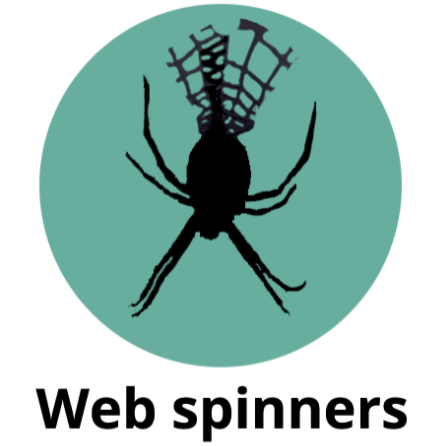
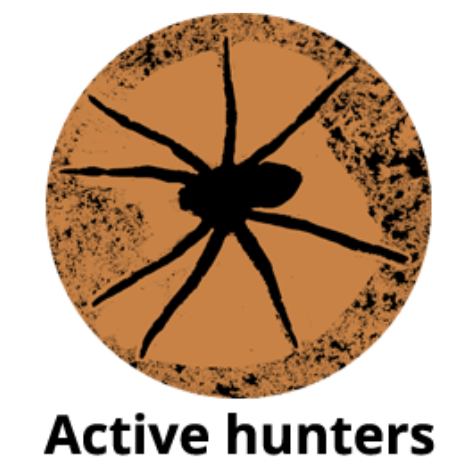
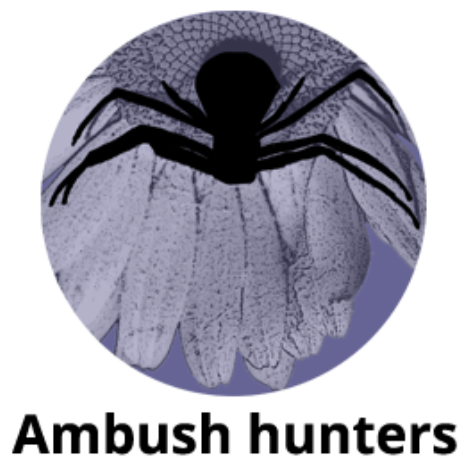

Spiders live among us in almost every conceivable habitat. Their ecological role, one that benefits us, is as the ultimate predators of insects. They pursue this role with instinctive dedication; some have even moved into the warm micro-climates of people's homes, unwittingly protecting us from pesky insects. In turn, they are a food source for many animals, forming an important link in the food chain.
Evolution has equipped spiders with a myriad of techniques for capturing insect prey: jumping spiders leap, crab spiders ambush, wolf spiders give chase and web-weaving spiders entrap. The earliest spider fossils date back 300 million years, and the creatures probably developed at least 100 million years before that, during the Devonian period. No other group of animals has been hunting insects so efficiently for so long.
Although feared by many, Ontario spiders are generally not dangerous and hardly ever bite humans. Most spiders use venom, delivered from an opening in their chelicerae (jaws), to subdue and predigest prey. In Ontario, however, only the rare and shy northern widow spider (Lactrodectus variolus) is considered dangerous to people. Even from this species, a bite is very unlikely to be fatal.
Both insects and spiders are arthropods (invertebrates with jointed legs). Insects form one class of arthropods, while spiders are an order – a level that is subordinate to a class – of arachnids. Other arachnids include harvestmen (daddy-long-legs), scorpions, ticks and mites. Spiders differ from insects in having eight rather than six legs, simple rather than compound eyes, two main body parts (abdomen and cephalothorax – a fused head and thorax) instead of three, no antennae and, of course, no wings.
In Ontario, the best time for observing spiders is from late spring to early fall. Early morning dew or frost reveals webs that are nearly invisible at other times. Some adult spiders do not live past the fall season, while others overwinter under bark, in leaf litter or in other shelters. Yet some spiders can be observed year-round. Yellow sac spiders (Cheiracanthium mildei), longbodied cellar spiders (Pholcus phalangioides) and others share our homes, egg cases can be found on buildings and vegetation, and thinlegged wolf spiders (Pardosa spp.) may take advantage of a sunny, mild winter day to catch some rays on a stump or log.
Researchers have discovered astonishingly high densities of spiders in certain habitats. For example, a British researcher once estimated a total of about 5.5 million spiders in a productive hectare of meadow.
These myriad of spiders are quite diverse. Closer to home, more than 800 species, representing 35 families, have been found in our province, and these numbers continue to grow as new spiders are reported.
Spiders can be daunting to identify. The colour of a species is often quite variable even when mature, while immature spiders are often very different than adults. Males and females of the same species may be similar or quite different in coloration and size. Males are slightly or much smaller than females. The pedipalps of the males resemble boxing gloves (for transferring sperm).
Learning family characteristics helps greatly. Among web-weavers, the type or location of web often distinguishes the family. Families can also be identified by the arrangement of the spider's eyes. Some species are so distinctly marked that identification in the field is easy.
The following guide, of course, is not comprehensive. Instead, an effort has been made to choose species and families to represent the following: first, commonly observed spiders; second, distinctive and dramatic species; and third, examples of some unusual families that make our arachnofauna so diverse and interesting.
Note: Sizes listed refer to body length (excluding legs).
Web spinners
Orb weavers
Family Araneidae
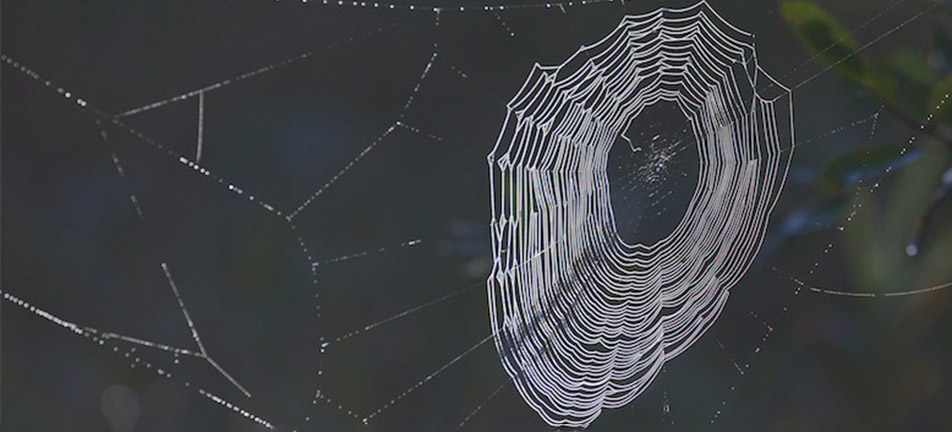
Orb weavers are nature's poster spiders. Their spiralling orbs with strong support lines make a highly effective insect snare. From start to finish a web, which can contain up to 20 metres of silk and 1,000 to 1,500 connections, may be created in a mere 30 minutes. Remarkably, an orb weaver spider can weigh more than 1,000 times the weight of the web on which it lives. Orb weavers will eat and remake webs every few days – or sometimes daily – recycling 90 percent of the silk used for the original web.
Orb weavers rotate trapped insects with their forelegs while their hind legs pull out silk from the spinnerets to wrap the victim. Despite possessing eight eyes – arranged in two rows of four – an orb weaver's vision is poor, rendering it dependent on sensing vibrations from its web.
Yellow garden spider (Argiope aurantia)
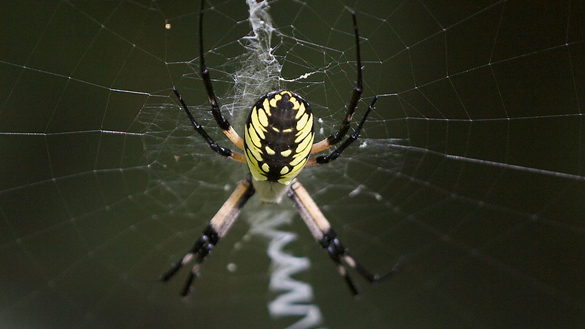
Description: This is one of Ontario's largest orb weavers. The body length of females (cephalothorax and abdomen) ranges from 19 – 28 millimetres; males are much smaller, at five to nine millimetres. Silver hairs adorn the upper half of the cephalothorax, while the black, egg-shaped abdomen has striking yellow markings. The legs are pale at the base, and darker towards the tips. The much smaller male is pale, sometimes orangeish. The large webs of this species (and the banded garden spider below) have a broad, zigzag "stabilimentum" running from top to bottom.
Habitat: Meadows, shrubby areas, yards and gardens
Range: Most common in south-eastern Canada and the eastern United States.
Seasonality: Summer through early fall
Trivia: On these orb webs, only the spiral webbing is sticky, leaving the stronger "spokes" and support lines easy for the web master to grasp.
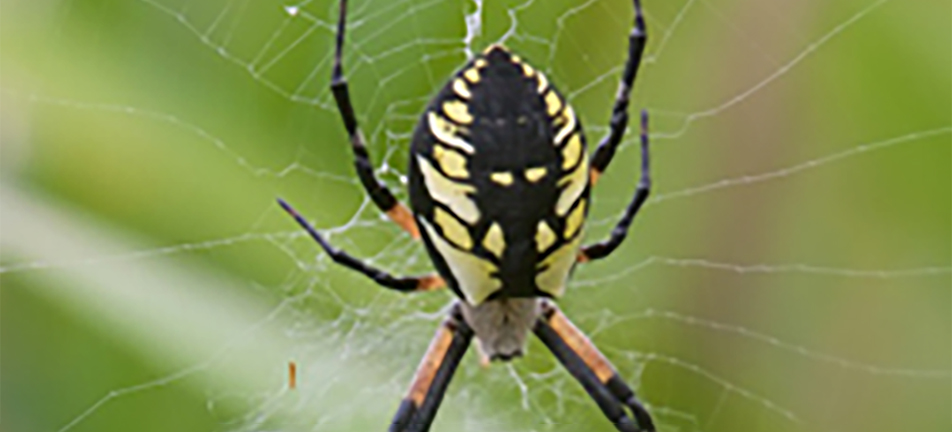
Banded garden spider (Argiope trifasciata)
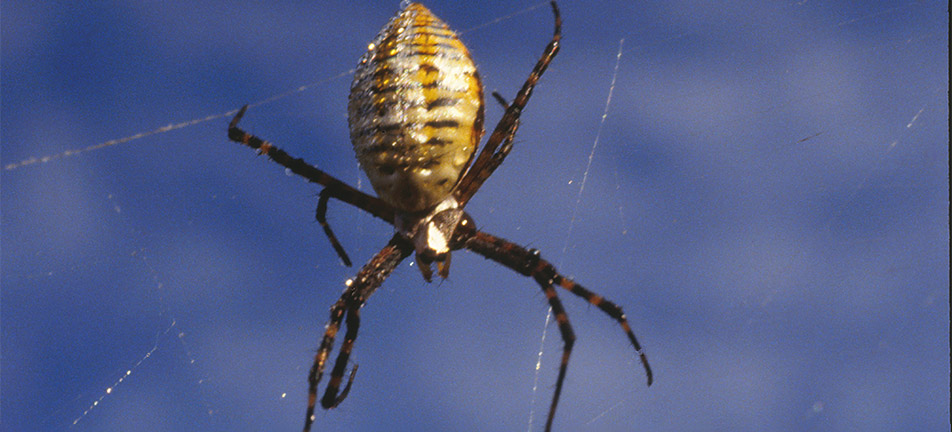
Description: This is a large orb weaver. Females are 15 – 25 millimetres; males are 4 – 5.5 millimetres. The celphalothorax is silver, while the abdomen is crossed with silver, black and yellow bands. The legs are pale yellowish-orange banded with black.
Habitat: Meadows, shrubby areas, yards and gardens
Range: In many places throughout the world (cosmopolitan distribution), including across southern Canada and the United States
Seasonality: Summer through early fall
Trivia: When disturbed, banded garden spiders may "trampoline" (springing their web rapidly back and forth) to confuse predators.

Cross orbweaver (Araneus diadematus)
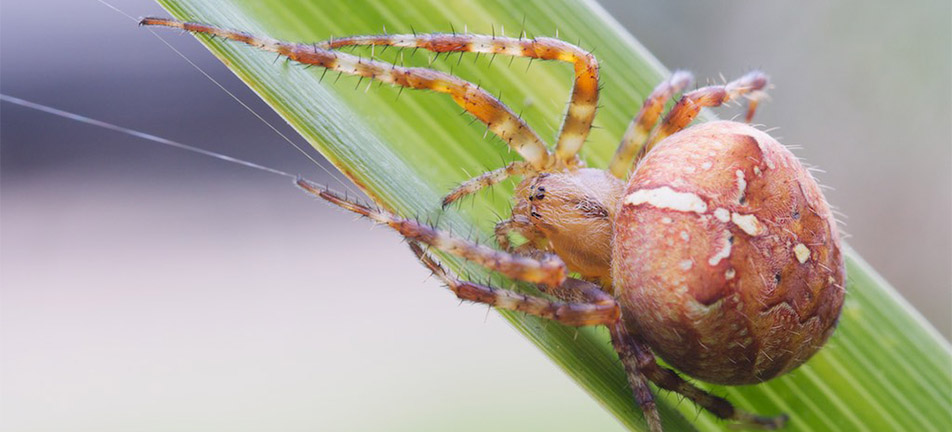
Description: This is a large orb weaver. The female ranges from 7 – 20 millimetres; the male from 6 – 13 millimetres. The abdomen's base colour varies from dark brown to orange and reddish. The dorsal abdomen shows white spots that form the shape of a cross. There is a darker patch on the posterior half of the abdomen. The legs are banded light and dark.
Habitat: Large webs are often observed around buildings and in gardens
Range: Introduced from Europe to North America at least 100 years ago, where it is now present in south-eastern Canada (including Ontario) and the west (including British Columbia)
Seasonality: Summer through early fall
Trivia: The cross orbweaver spider (called the garden spider in Europe) was venerated in the Middle Ages due to the dotted cross on its back.

Furrow orbweaver (Larinioides cornutus)
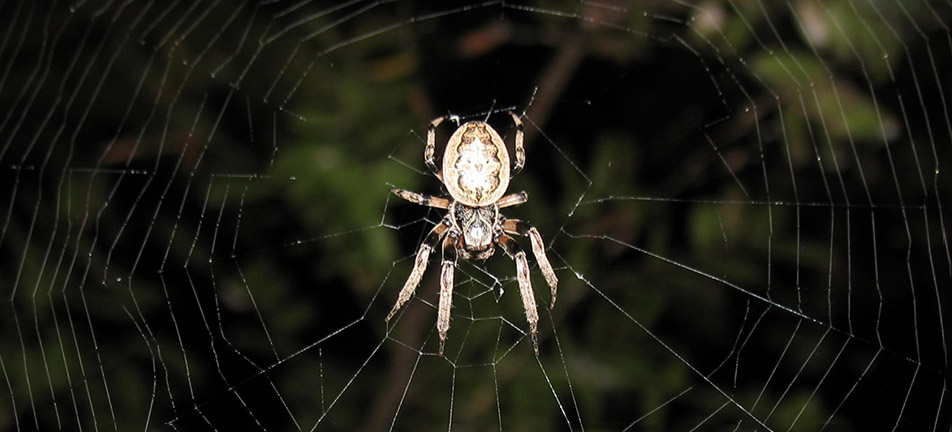
Description: A medium-sized orbweaver. Females range from 6.5 – 14 millimetres, males from 5 – 9 millimetres. The cephalothorax is shiny brown. The abdomen is pale, with a dark "folium" mark on back that appears faded towards the middle and darkest at its edges. The legs are banded tan and brown.
Habitat: Very common beside bodies of water, especially lakeshores, also often on buildings
Range: Across Canada and through the United States
Seasonality: Year round
Trivia: This species sits on its web at night, hiding in a retreat such as a folded leaf or crevice during the day.
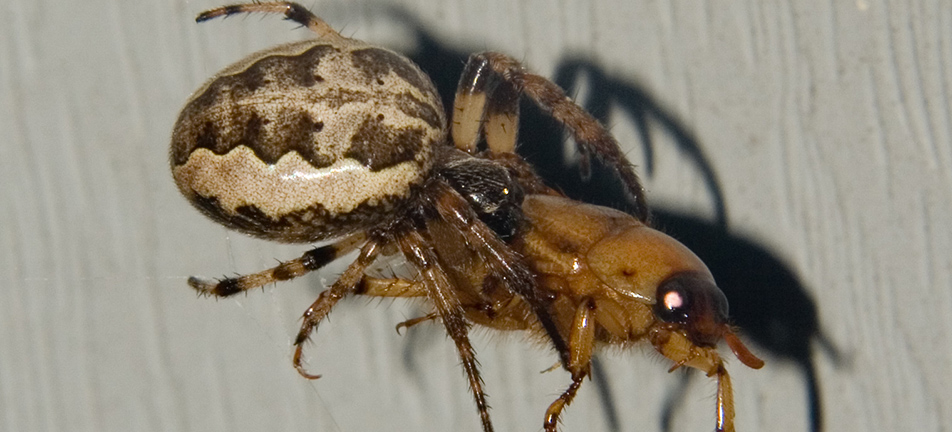
Bridge orbweaver (Larinioides sclopetarius)

Description: A medium-sized orbweaver. Females range from 8 – 14 millimetres, males from 6 – 7 millimetres. The cephalothorax is dark with thin white lines along the edge created by hairs. The abdomen has a dark "folium" mark outlined by white. The legs are banded dark and light.
Habitat: Most often found on human structures, such as on windows or around lights on buildings, and of course on bridges. Probably introduced from Europe, this species seems to prefer attaching its web to metal, brick or other non-natural material.
Range: South-eastern and South-western Canada and the adjoining states.
Seasonality: Year round.
Trivia: This species may be found very high up on tall buildings.
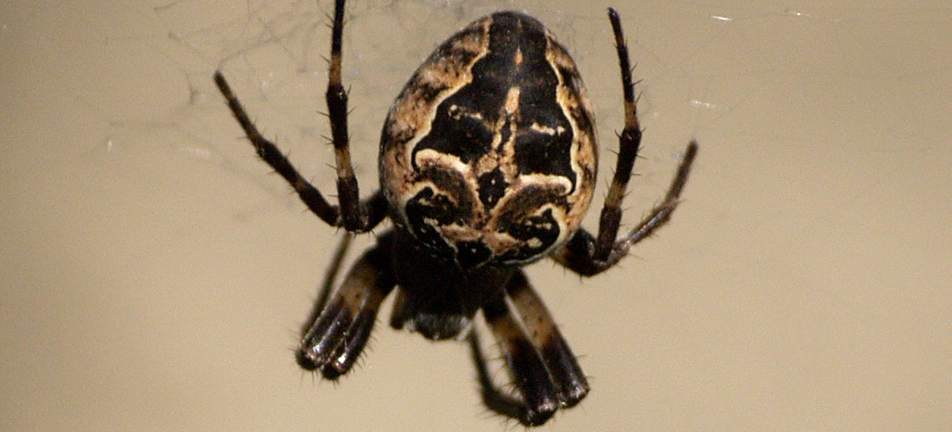
Shamrock orbweaver (Araneus trifolium)
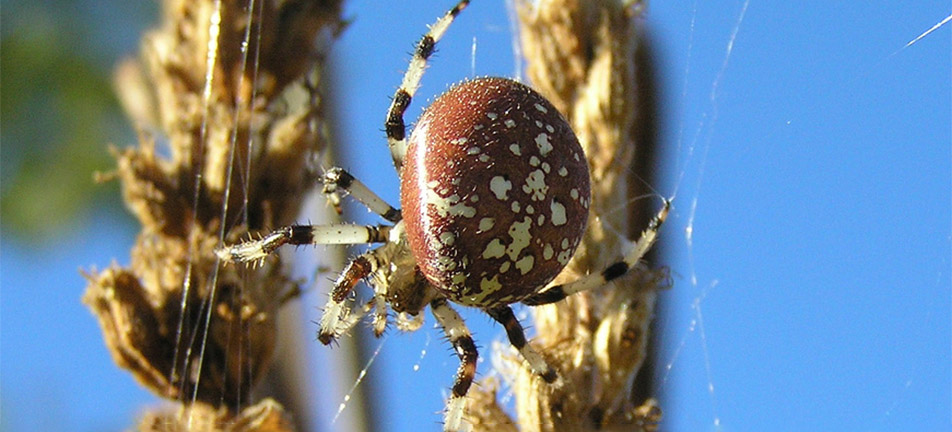
Description: A large orbweaver. Female 9 – 20 millimetres, male 5 – 8 millimetres. The cephalothorax is pale with one median and two lateral broad dark lines. The legs are strongly banded dark and pale. The abdomen base colour varies, often cream-coloured but also red, yellow and green are possible. The abdomen has a profusion of light spots of varying sizes. The male has a cream-coloured abdomen, with a reddish cephalothorax and darkly banded legs.
Habitat: Prefers open areas, such as meadows, swamps and marshes, especially if damp
Range: Across Canada and through much of the United States
Seasonality: Summer to fall
Trivia: Shamrock spiders can change their abdomen colour to match their surroundings, with the red form often being found among red leaves in autumn.

Starbellied orbweaver (Acanthepeira stellata)
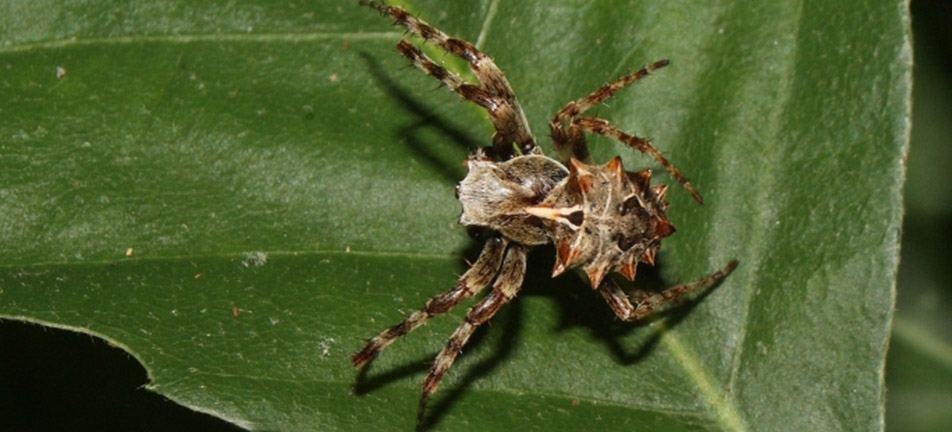
Description: A medium-sized orbweaver. Females range from 7 – 15 millimetres, males from 5 – 8 millimetres. Between 10 and 12 points jut out from the abdomen's edge, giving this spider a somewhat star-like shape and making it easy to identify in the field. Even its two lateral (side) eyes are set on points. There is a darker patch near the abdomen's tip. Varying brown shades and bristles give this spider a burr-like appearance.
Habitat: Most common in meadows and grasslands
Range: Southeastern Canada south to Florida
Seasonality: Late spring through early fall
Trivia: Disturbance will often make this species drop quickly to the ground, where its superb camouflage makes the spider very difficult to find.
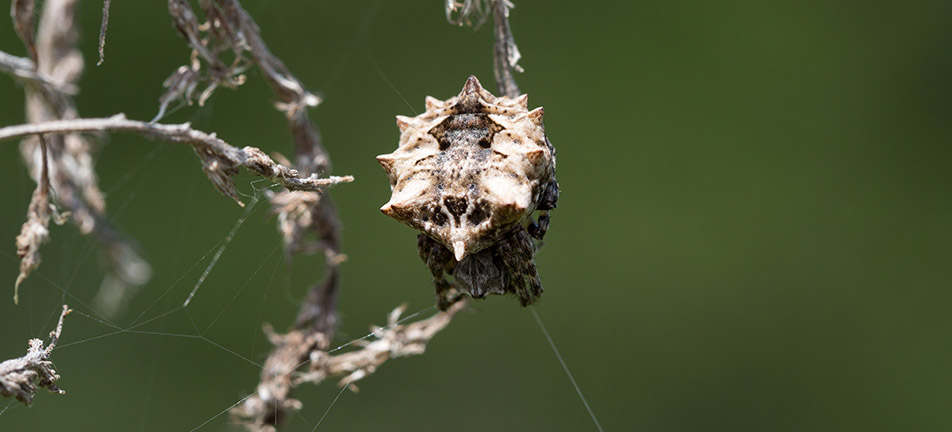
Conical trashline orbweaver (Cyclosa conica)
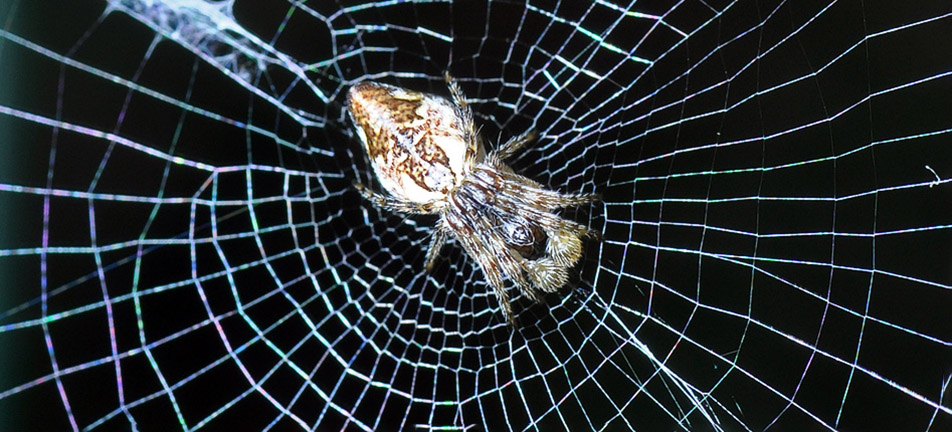
Description: This is a small orbweaver. Females range from 5 to 7.5 millimetres, males from 3 to 4 millimetres. The cephalothorax is dark brown. The abdomen is white with various brown patterns, and has a distinctive lobe extending from its posterior which accounts for part of its common name. The legs are pale brown. The vertical web is often as high as eye level, and includes many spokes and spirals that continue right to the web's centre.
Habitat: Shrubby meadows, open woodlands, parklands and gardens.
Range: Widespread across Canada
Seasonality: Spring through fall
Trivia: This species (and a similar species –Cyclosa turbinata) spin a web that often includes a "trashline," a vertical line of debris including old, silk-wrapped prey and bits of vegetation. Sometimes, however, the web is unadorned or may just have a silken "stabilimentum" like that of the garden spiders.

Long-jawed orb weavers
Family Tetragnathidae
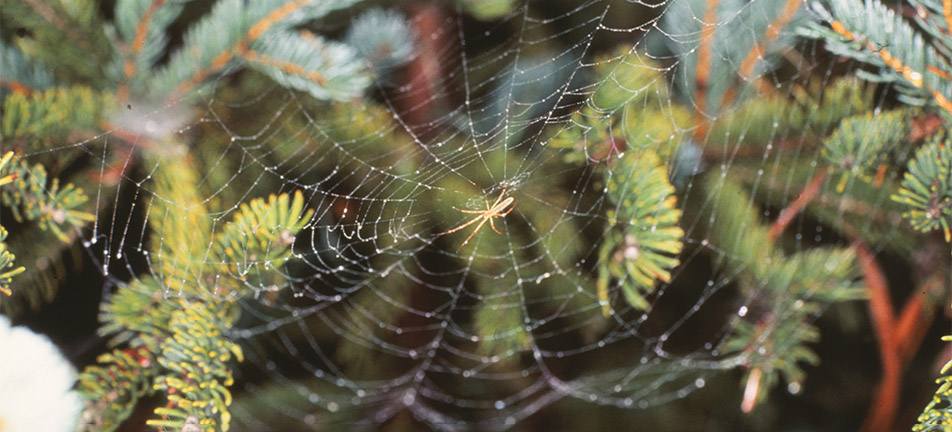
This family constructs orb webs, but these are usually angled greatly from vertical and may even be nearly horizontal. There is an open hub in the web's middle where the spider can easily pass from one side to the other. Tetragnathids are long, slender spiders with prominent chelicerae (jaws) that are two-thirds the length of – or longer than – the cephalothorax. These spiders hide in grass, extending their long first, second and fourth pairs of legs lengthwise while clinging to blades of grass with their much shorter third pair of legs. Their webs are small- to medium-sized orbs with few radiating supports and are usually suspended at an angle between branches of shrubs. The small eyes are arranged in two rows. These spiders can be very difficult to identify to the species level. The orchard spider is an exception to this, but identifying others to the genus level in the field is sometimes best (e.g. Tetragnatha sp).
Silver long-jawed orbweaver (Tetragnatha laboriosa)
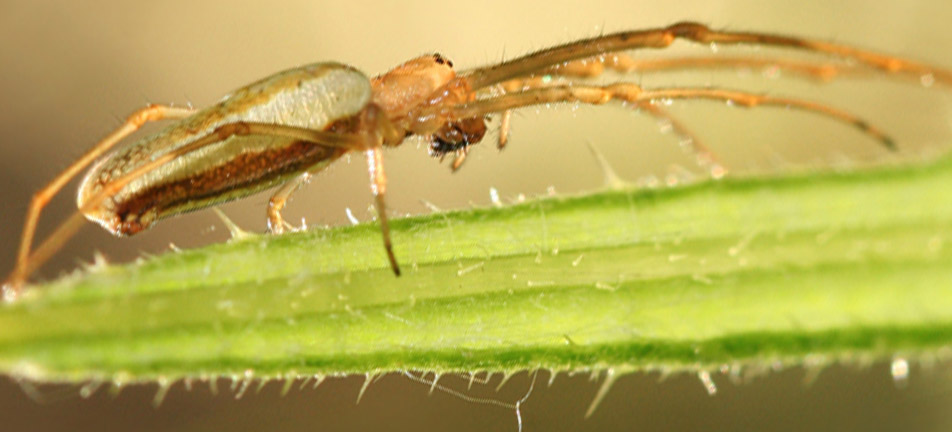
Description: A medium-sized spider. Females are 5 – 9 millimetres; males 4 – 7 millimetres. Its abdomen is most often silvery white, sometimes tinged with yellow and marked with a longitudinal darker patch. The abdomen is less elongated compared to many other members of its genus (Tetragnatha). The cephalothorax and legs appear shiny brown.
Habitat: May be found in low vegetation, shrubs or low branches of trees
Range: Widely found in Canada and the United States
Seasonality: Spring through fall
Trivia: Because of its poor vision, this spider often keeps to one side of its web with one leg touching a supporting line to sense the vibrations of a trapped insect. If disturbed, the spider will drop to the ground out of sight.
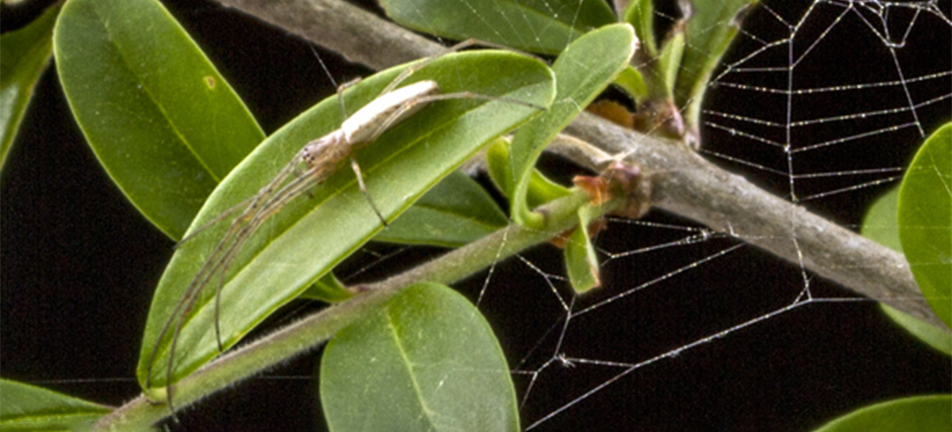
Orchard orbweaver (Leucauge venusta)
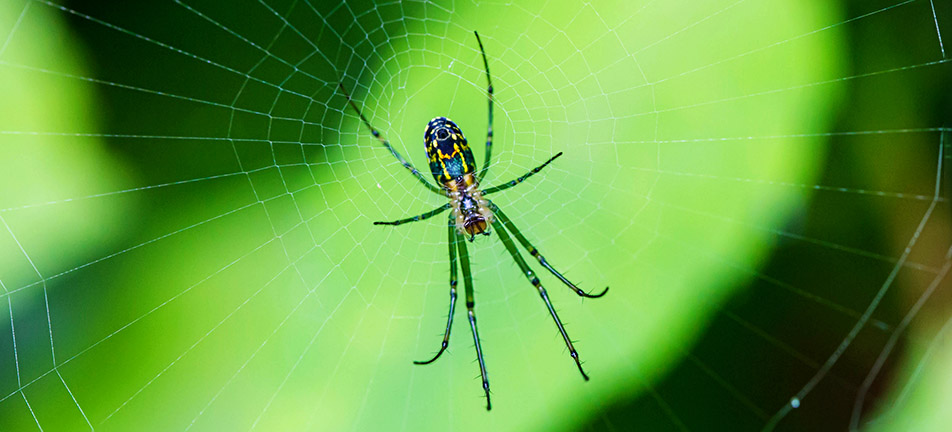
Description: A medium-sized spider, female 4 – 8 millimetres, male 3 – 5 millimetres. Its legs are green, the cephalothorax is light brown, while the white abdomen is patterned with black and green lines, and yellow and reddish patches. One green line forms a circle around the abdomen, which encloses a central line with backwards angling branches. This is a strikingly beautiful spider.
Habitat: Shrubs and low branches of trees, moist forested areas
Range: Throughout much of eastern North America, including southern Ontario and Quebec, and California
Seasonality: Late spring and summer
Trivia: Like most long-jawed orb weavers, the orchard orbweaver's webs are inclined on an angle, often being nearly horizontal.
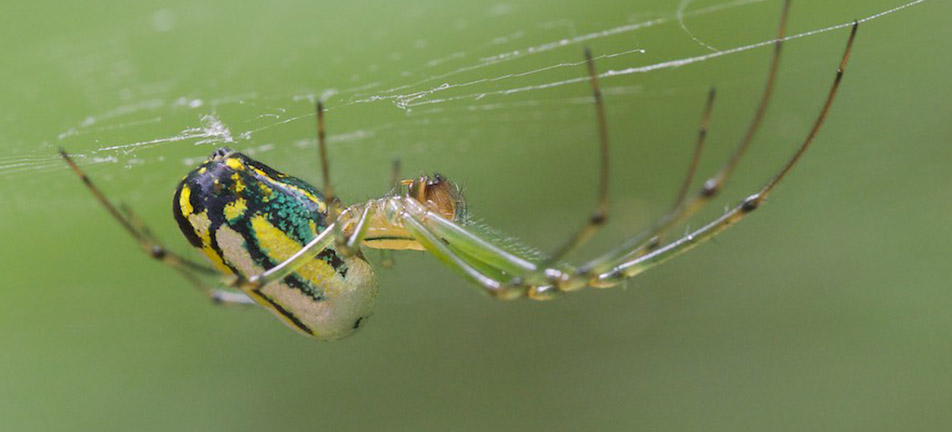
Cobweb weavers
Family Theridiidae

This family's tangled, messy but effective webs fill spaces such as corners on a building, within tree crevices, hollows or among vegetation. Their abdomen is very large and globular, and they have very long legs. A comb of curved bristles (setae) on their back pair of legs is used to throw silk strands over insect prey that has become entangled in the web. Once the prey is subdued, the cobweb weaver injects venom, drags it further into the web and sucks the juices from its prey. The eyes are arranged in a fairly tight group, making a rather narrow horizontal oval.
Common house spider (Parasteatoda tepidariorum)
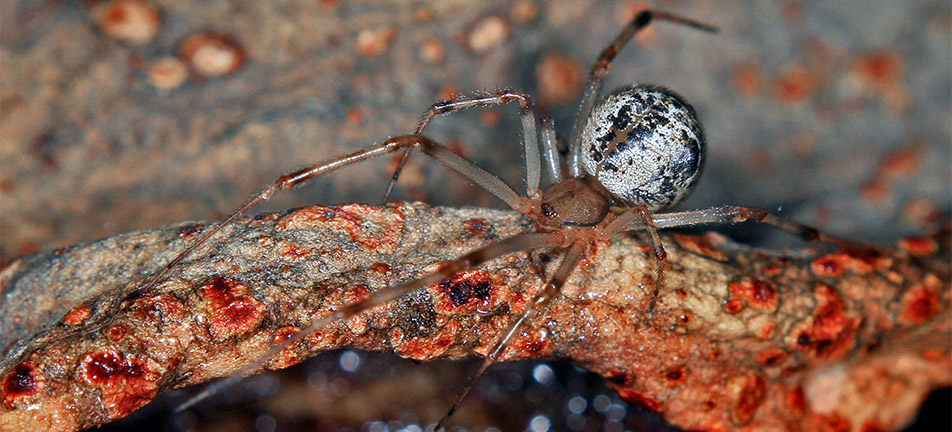
Description: A medium to large cobweb weaver. Females range from 5 – 7 millimetres, males from 4 – 6 millimetres. The cephalothorax is mid-brown to tan. The large and globular abdomen varies greatly in colour, but is often pale with many dark spots and swirls, giving it a mottled appearance. Some specimens may be overall dark or pale. The joints of the legs are dark. Males may have a reddish tinge.
Habitat: Usually encountered inside or on the exterior of buildings, often in corners
Range: Virtually a world-wide distribution in and around buildings
Seasonality: Indoors year-round; outdoors spring to mid-fall in Ontario. Tear-drop-shaped egg cases are visible on building exteriors through the winter.
Trivia: This is one of the world's most widely distributed spiders.
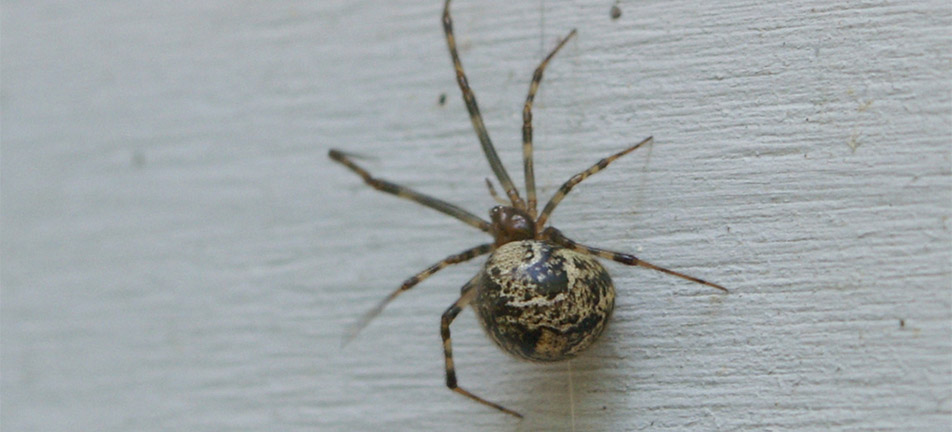
Northern black widow (Latrodectus variolus)
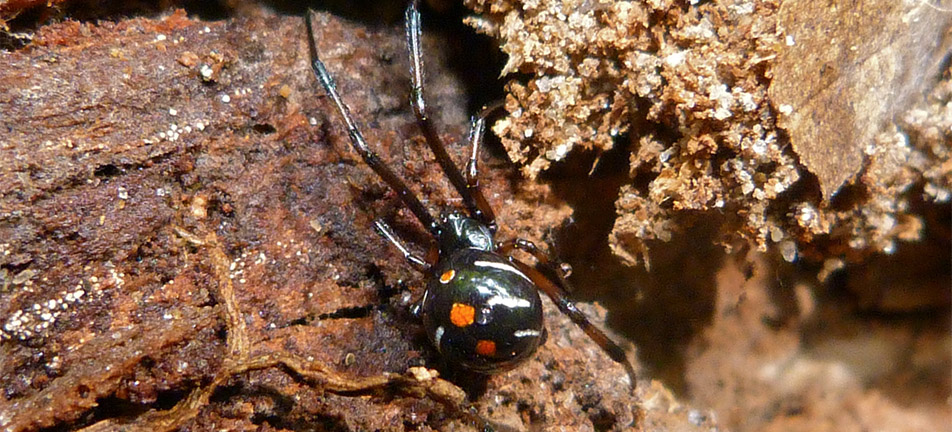
Description: This species is among the largest cobweb weavers. Females, at 12 to 16 millimetres in length, are significantly larger than males, at 10 to 12 millimetres, although the males possess longer legs and narrower abdomens. Overall shiny black in colour, they have a red "hourglass-shaped" pattern on underside of abdomen. Unlike southern widows, this "hourglass" is broken in the middle by a small black gap in our northern widows, and they also may have red marks on top of the abdomen.
Habitat: Northern black widows spin messy webs on stumps or logs, under stones, in holes and occasionally in barns and rural privies
Range: Eastern North America including various Ontario locations
Seasonality: Year round
Trivia: Shy and retiring, northern black widows seldom bite people. Although the bite is painful and may cause laboured breathing and severe abdominal pains, it is rarely fatal.

Candy stripe cobweb weaver (Enoplognatha ovata)
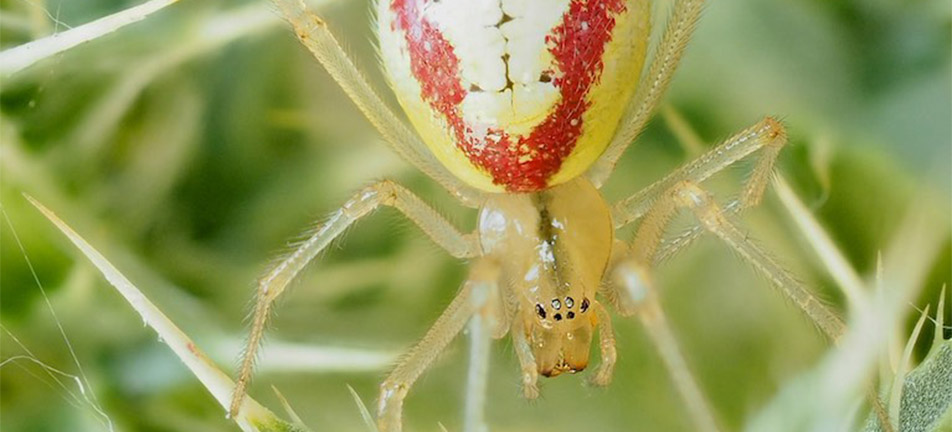
Description: A fairly large cobweb weaver. Females range from 4.3 – 7 millimetres, males from 3.5 – 5.2 millimetres. The pale cephalothorax has a faint dark middle stripe and two dark lines along the sides. The classic abdomen coloration has one red central stripe or two parallel, jagged red stripes, but this variable spider may be white, cream or yellow with or without lines of black dots on the abdomen. There is usually a dark band at the end of the tibia (the leg's second part).
Habitat: Forest understory, among tall plants in meadow
Range: Found in northeastern and northwestern United States and adjacent parts of southern Canada
Seasonality: Spring and summer
Trivia: Like some others of our spiders, this species originated in Eurasia and is now established in North America.
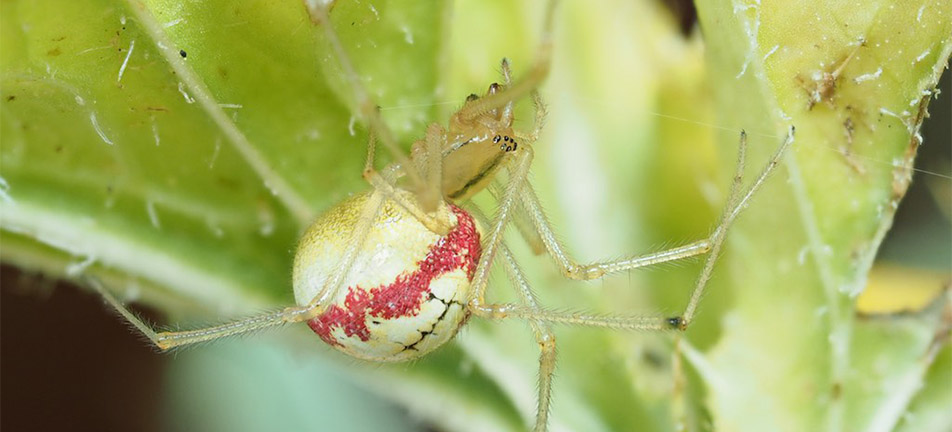
Cellar spiders
Family Pholcidae
In Ontario, one species of this family is highly adapted to living in human habitation (therefore the name "cellar spider.") A spider with the description below, living among a messy web, is unmistakable. Tolerance of these spiders in less-used areas of the house, like the cellar, will allow for many observation opportunities, including their rapid defensive gyrations which defend them from their main predators, which are wasps. In the southwestern United States, species in this family also inhabit caves and dark crevices.
Longbodied cellar spider (Pholcus phalangioides)
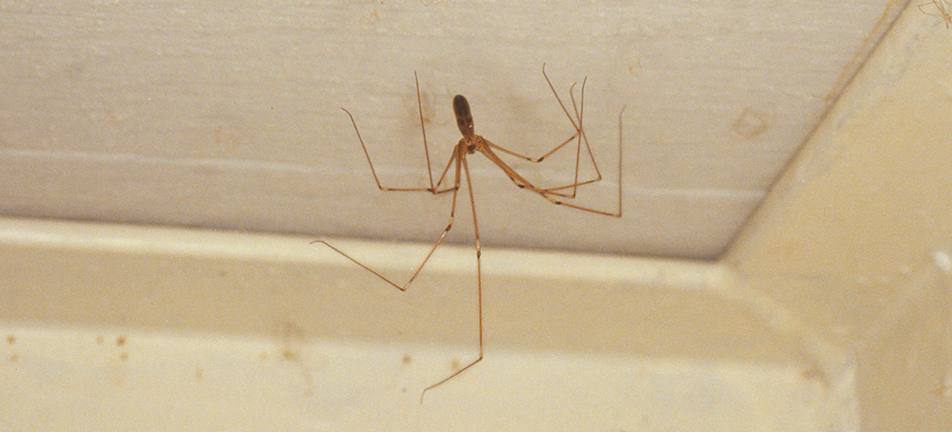
Description: This is a medium-sized spider. This female ranges from 7 – 9 millimetres, the male from 6 – 7.5 millimetres. Overall it has a long, narrow, grey body, with extremely long legs. The abdomen is long and narrow. The cephalothorax may have a dark longitudinal mark that divides in two towards the abdomen. The upper leg joints are banded black and white.
Habitat: In buildings, especially in darker recesses of basements, as their name suggests
Range: Nearly worldwide
Seasonality: Year round
Trivia: This family is often referred to as daddy longlegs, which confuses them with harvestmen (which are not spiders) and craneflies. These spiders were at one time (wrongfully) considered to be among the most poisonous of the world's spiders.
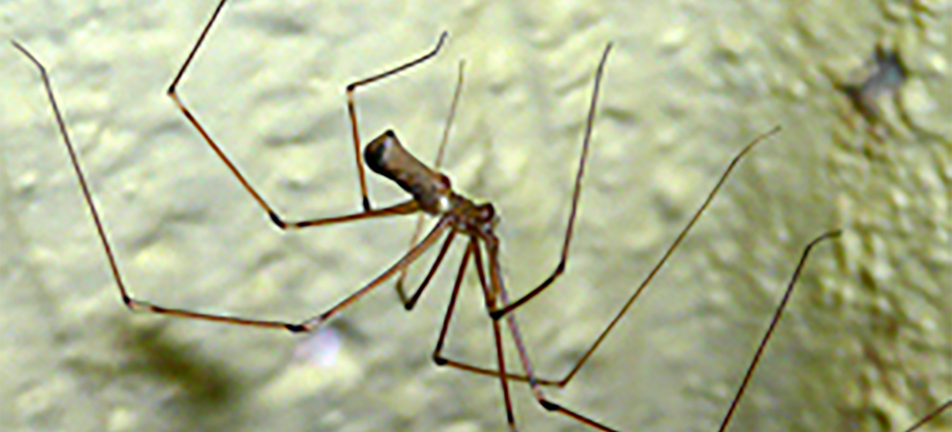
Sheet-web weavers
Family Linyphiidae
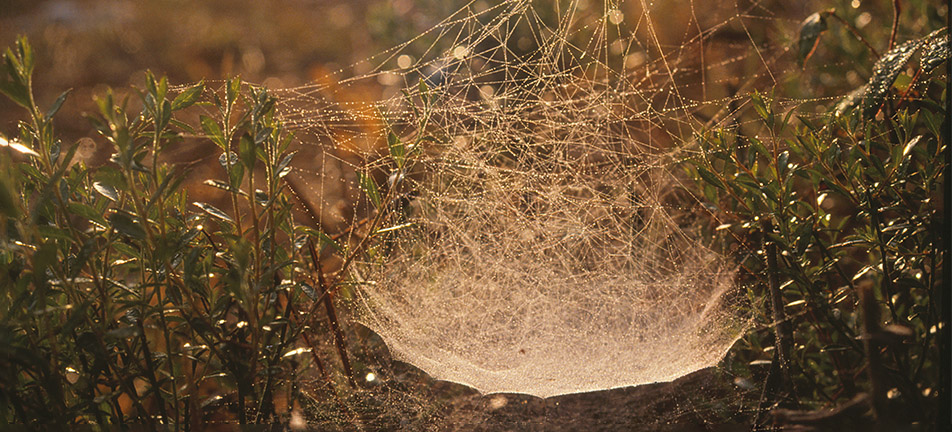
Many of these spiders are so tiny that identifying them by web type is most effective. The webs of these sheet-web weavers consist of a flat or curved sheet-like web below "knockdown" strands of silk that entangle tiny prey. The weaver clings to the bottom of the sheet or hides at the edge, ready to rush out and bite its victim from below and drag it through the web. Dewy sheet-web weaver webs decorating low plants and shrubs almost magically transform a meadow or shrubby area in the early morning light. This group is the most accomplished in "ballooning," extruding silken threads to carry themselves on the wind to new locations. Ballooning spiders have been collected thousands of metres above the ground, and hundreds of kilometres out at sea. A subfamily of this group (the dwarf spiders) either build very small webs or none at all, but are also accomplished ballooners.
Bowl and doily weaver (Frontinella communis)
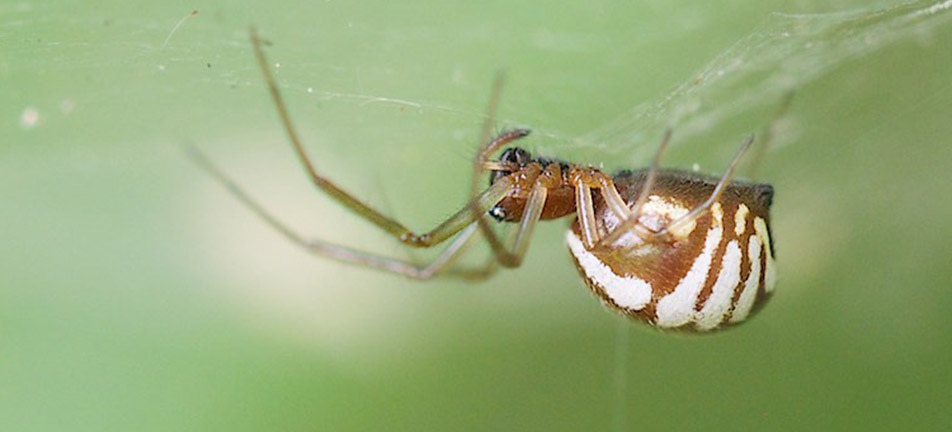
Description: This is a very small spider. The female is 3 – 4 millimetres, the male about 3 millimetres. The cephalothorax is dark and the abdomen is dark brown on top with sides striped dark and white.
Habitat: Meadows and wetlands, low vegetation, shrubs and lower branches of trees.
Range: Across North America, more common in the east
Seasonality: Late spring through summer
Trivia: When seen with early morning dew, bowl and doily weaver webs become suddenly obvious, festooning low tree and shrub branches. Male and female may cohabit the same web.

Hammock spider (Pityohyphantes costatus)
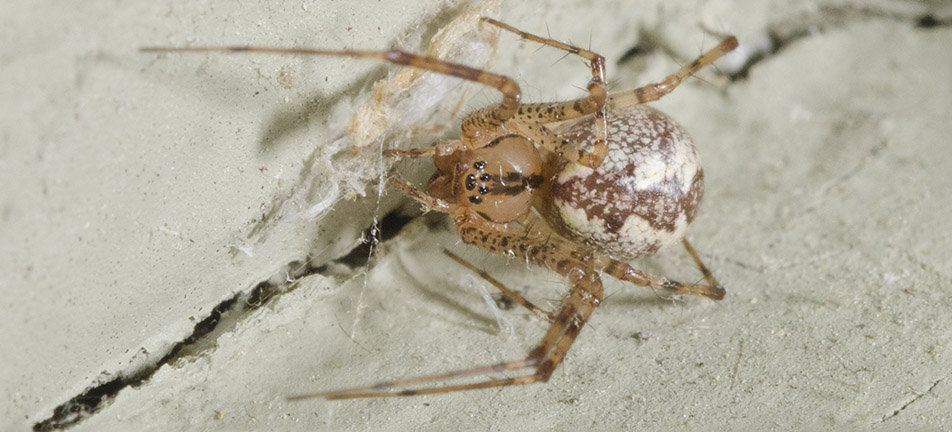
Description: Although a small spider, hammock spiders are large for this family. Females range from 5 – 7 millimetres, males from 4.5 – 6 millimetres. The cephalothorax is pale, with a dark mark like forceps starting in two lines near the eyes and joining towards the abdomen. The light-coloured abdomen has a central line resembling repeating arrowheads. The legs are pale with thin dark bands. The web is large for the spider's size and shaped like a hammock (a large, flat sheet).
Habitat: Low tree branches and shrubs.
Range: Widely distributed, primarily in eastern North America.
Seasonality: Spring to late summer.
Trivia: Members of this family are called "money" spiders in Britain, originating from the belief that it is lucky to have one land on you. This group is the most common of the "ballooning" spiders; therefore they are often carried by wind currents.

Splendid dwarf spider (Hypselistes florens)

Description: A very small but spectacularly coloured spider. Females are 2.5 – 3.0 millimetres, males are 2.0 – 2.3 millimetres. The cephalothorax is bright reddish orange, contrasting with a shiny black abdomen.
Habitat: Weaves tiny sheet webs near or on the ground, often among leaves, under rocks or in low vegetation, may be found higher on plants at night
Range: Across southern Canada and the northern United States
Seasonality: Spring through late summer as adults
Trivia: This species is sometimes observed in winter on snow.

Funnel-web weavers
Family Agelenidae
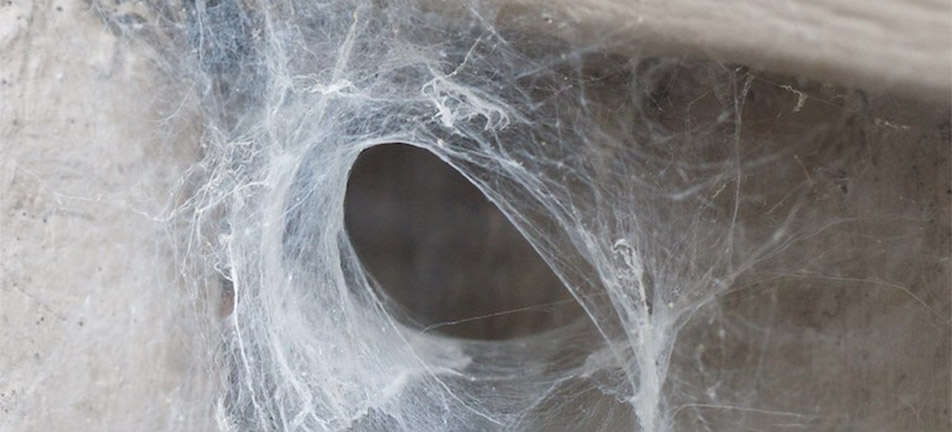
This family of spiders typically constructs a flat, sheet-like web with an attached funnel-like hideout. The web is often supported by grass or small tree branches, or may be constructed inside a shelter such as a tree trunk crevice or between rocks. These spiders conceal themselves in the narrow end of the funnel and wait for insects to stumble onto the web. When the spider senses a vibration, it charges out and subdues its victim with a paralyzing bite. Most have long spinnerets that extend beyond the posterior abdomen. Most members of this family have four eyes arranged in a middle row with two widely spaced eyes below this line and two narrowly spaced above.
Barn funnel weaver (Tegenaria domestica)
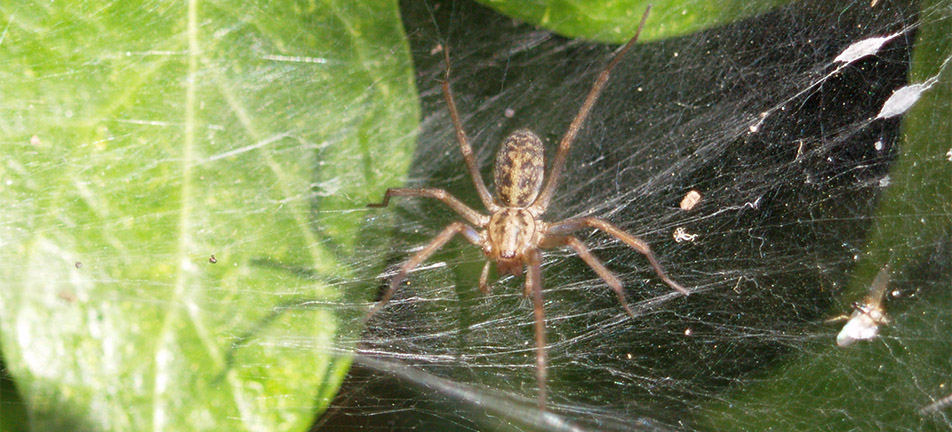
Description: The female is 7.5 – 11.5 millimetres, male 6 – 9 millimetres. The body is overall light brown with two darker lines extending back from lateral eyes on the cephalothorax. The abdomen has small dark patches which become chevron-shaped towards the back; spinnerets are just visible from above. The legs are long and thin with spine-like hairs and are usually banded.
Habitat: Damper areas in houses, especially cellars, also barns, other outbuildings, with the web often extending from openings or cracks in rock or cement walls
Range: Across the United States and into southern Canada
Seasonality: Year round
Trivia: During the breeding season, male and females of this species share the same web.
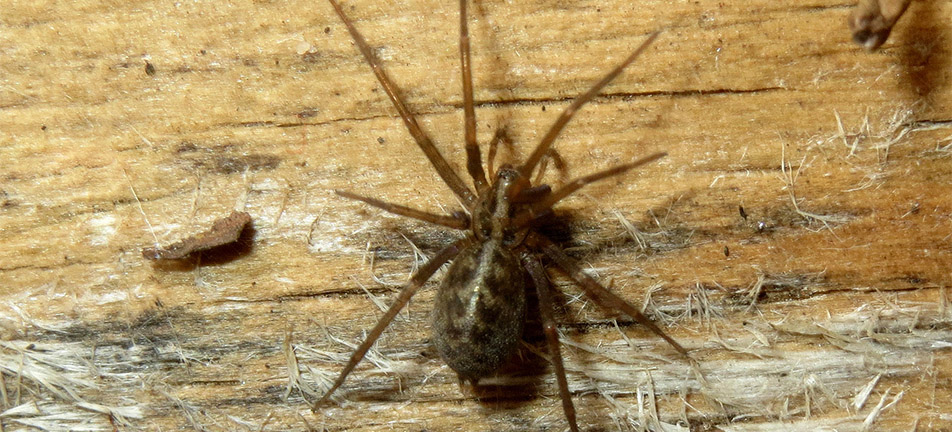
Grass spider (Agelenopsis spp.)
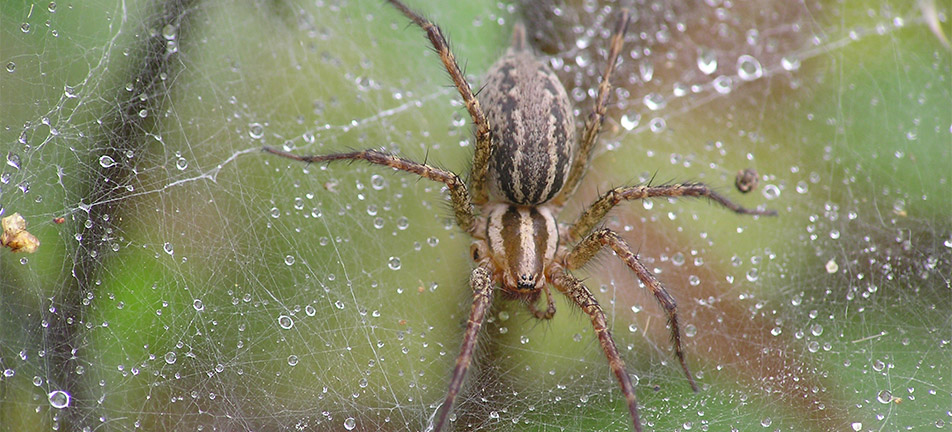
Description: Females ranges from 7 – 17 millimetres, males from 6 – 12 millimetres. These spiders are overall brownish-grey, with two dark parallel lines on the lighter cephalothorax, giving it a striped appearance. The abdomen is grey or brown and may have a lighter middle stripe, or two light parallel stripes that become dotted towards the back. There is a wide, dark middle band on the underside of the abdomen. The spinnerets are very long and can be easily seen from above. Species of this genus can be difficult to distinguish in the field.
Habitat: Most commonly found in open grassy areas where early morning dew reveals their webs. Also in low, dense coniferous trees or shrubs where the foliage gives support to the web. Occasionally found on forest floors. Males may also wander into buildings in search of a mate
Range: Widespread across Canada and the United States
Seasonality: Summer and fall
Trivia: These funnel web weavers have long legs and are remarkably fast.
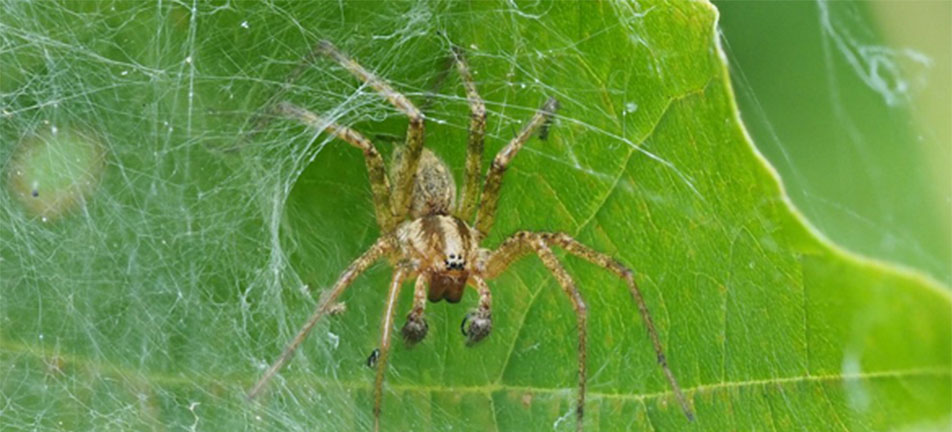
Mesh-web weavers
Family Dictynidae

This family of small spiders (less than 5 millimetres) may be most easily recognized by their distinctive web, although not all members of this family produce webs. The web often covers the tip of a small branch or plant head, or covers a leaf or is enclosed within one. Rather than sticky silk, these spiders use a cribellum, a sieve-like body part near the spinnerets to produce fuzzy silk to entangle prey. This is termed "hackled" silk. Although tiny, they are compact and heavy-bodied.
Hackledmesh weavers
Family Amaurobiidae
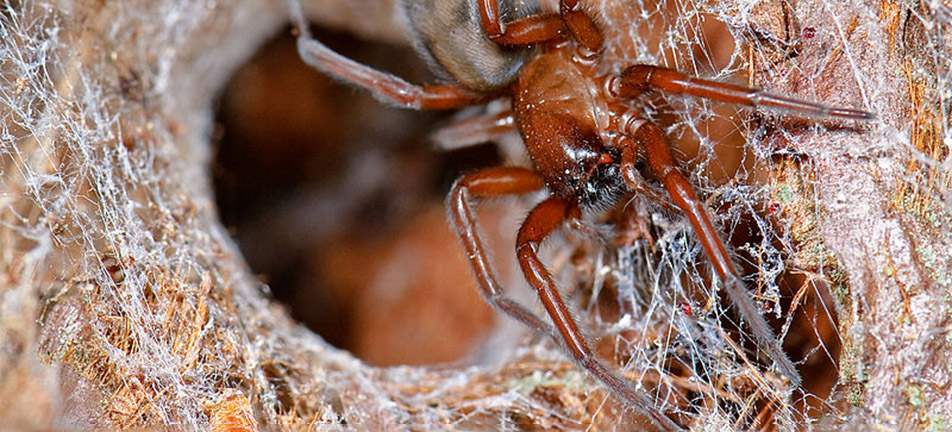
Most species in this family build webs with cribellate silk among leaf litter or under rocks or decaying logs. The webs are similar to funnel webs except for the fuzzy hackled silk which may appear messy.
Hackledmesh weaver (Callobius bennetti spp.)
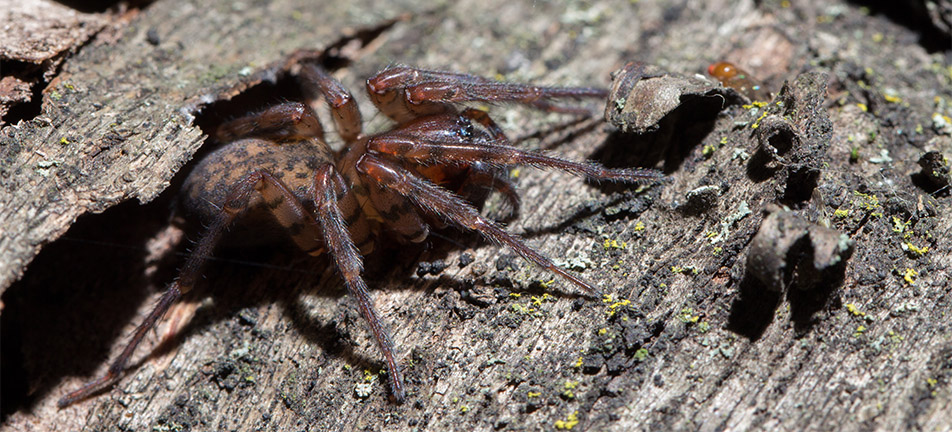
Description: A medium to large spider. Females range from 5 – 12 millimetres, males from 5 – 9 millimetres. The cephalothorax is reddish brown and shiny, and darker towards the face area. This species has large chelicerae. The abdomen is dark on each side; the pale middle dorsal patch is divided by a dark line at the front and becomes chevron-type markings towards the back. The legs are reddish-brown and shiny.
Habitat: A forest dweller, among leaf litter, under logs and rocks
Range: Newfoundland to Manitoba, south to central United States
Seasonality: Females year-round, males spring
Trivia: The Amaurobiidae family of spiders is also known as "tangled nest" and "night" spiders.
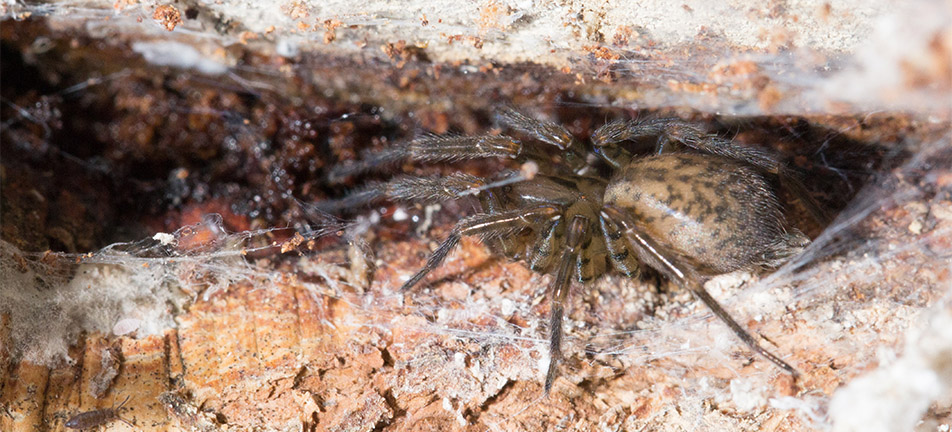
Active hunters
Wolf spiders
Family Lycosidae
Wolf spiders are primarily nocturnal hunters. Depending heavily on camouflage for protection, wolf spiders tend to be cryptically coloured (often grey or brown) to blend into their surroundings at night. Four eyes are arranged in a line beneath two very large eyes, and two more are mounted above and to the side of these. The two very large eyes distinguish them from the somewhat similar nursery web spiders, whose eyes are all relatively similar in size. Wolf spiders have excellent vision, as well as a keen sense of touch. These spiders are ground dwellers that chase their prey rather than use web snares or traps. Uniquely, females in this family carry their egg sac on their spinnerets, rather than in their jaws as with nursery web weavers. After hatching, the tiny spiderlings – that may number up to 100 or so – ride on the mother's abdomen.
Thin-legged wolf spiders (Pardosa spp. spp.)
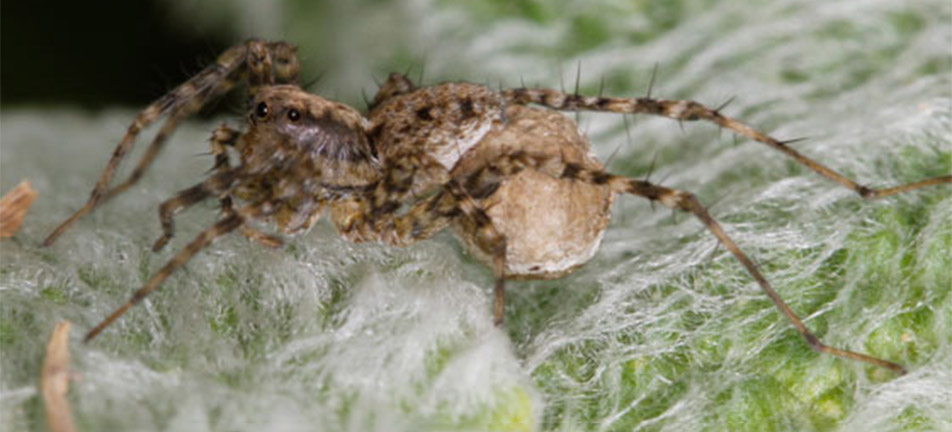
Description: A group of fairly small, common wolf spiders. Females range from 5 – 10 millimetres, males 4 – 7 millimetres. As their name suggests, this group has slim legs and are very fast runners for pursuing prey. Their face appears thinner rather than broadly convex (as in some other wolf spiders).
Habitat: On woods in leaf litter, also open grassy fields and lawns, shorelines
Range: SeveralPardosa species are widespread in Canada, especially the south but some range far into the north
Seasonality: Late winter to late fall
Trivia: These wolf spiders are swift runners that can chase prey over great distances.
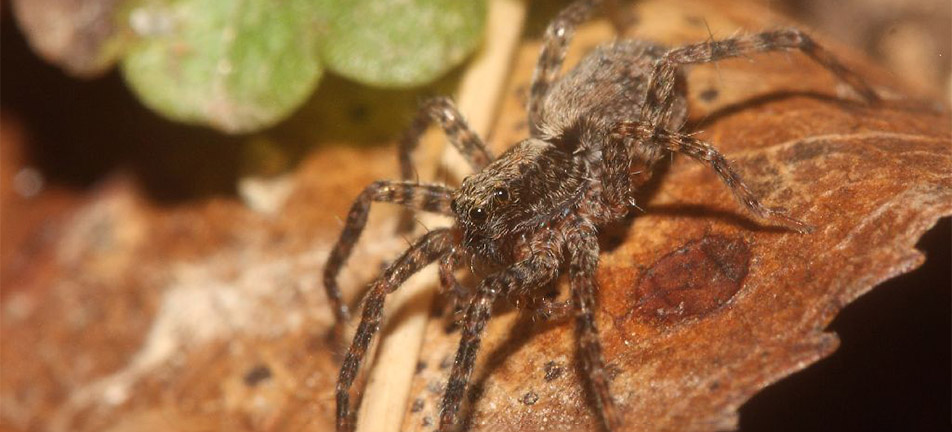
Tigrosa helluo
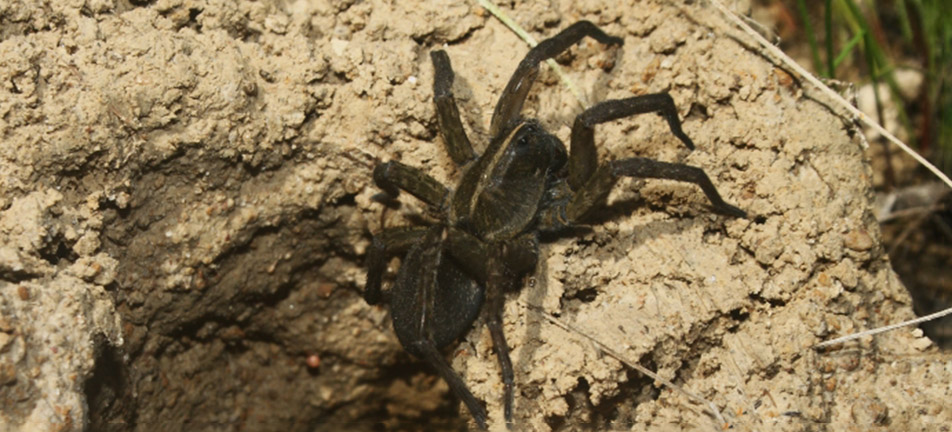
Description: A very large wolf spider. Females range from 18 – 21 millimetres, males from 10 – 12 millimetres. The female is overall dark brown with lighter brown legs. A tan stripe extends back on the cephalothorax from between the eyes. There is a darker patch that extends about half-way back on the dorsal surface of the abdomen. The male is overall lighter in colour, with two longitudinal stripes on the cephalothorax and a dark patch at the base of the pale abdomen.
Habitat: Fields and adjoining woodlands, prefers damp areas
Range: Southeastern Canada and eastern United States as far west as Colorado
Seasonality: Females all year, males late spring to early fall
Trivia: Like most wolf spiders, this species is primarily nocturnal. Walking with a headlight on a warm summer's night will reveal this and other wolf spider species' "eye-shine" in the grass or among the leaf litter of a forest.
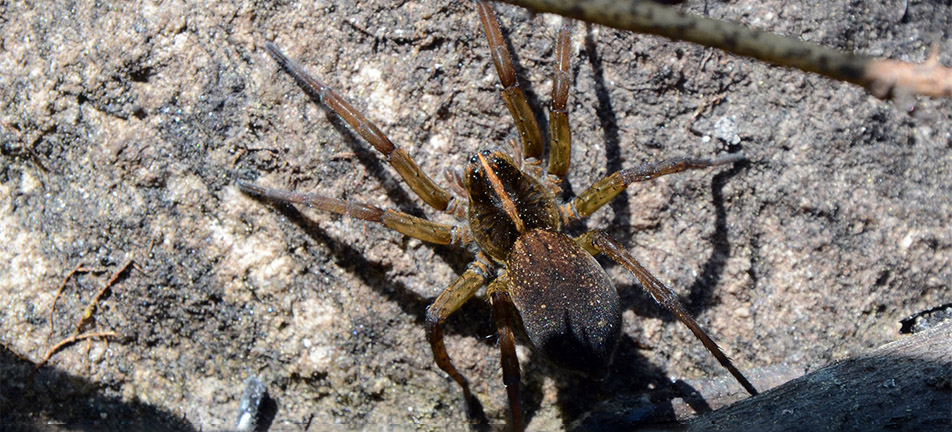
Jumping spiders
Family Salticidae
Even arachnophobic humans may be attracted to these eccentric spiders. Any sort of stimulus, like putting a finger near to a jumping spider, will likely elicit its jerky motion and namesake jump, to a nearby object or sometimes right onto the curious person. Two enormous owl-like eyes dominate the face of this family, whose members rotate their cephalothorax to peer at nearby objects. They have binocular and colour vision, and can adjust their eyes' focus by changing the shape of the retina. This results in extremely accurate judgement of distance, and an accurate pounce on unlucky prey. A silken dragline is set down in case of a miss. Jumping spiders also use silk to weave retreats in which they moult, rest and hibernate. With over 5,000 species described world-wide, Salticidae is the most diverse spider family, comprising approximately 13 percent of all species.
Bold jumper (Phidippus audax spp.)

Description: A large jumping spider. Females grow to 15 millimetres, males to approximately 13 millimetres in length. The face has iridescent green chelicerae. The female's body is overall black and bristly, with three contrasting white or orange dots on the abdomen. She may also have a white band on the front of the abdomen, tapering as it goes back. Males have a similar but broader white band at the front of the abdomen that also tapers toward the rear, and have orange or white spots on the dorsal abdomen. Another male form has much more colour, with white on the cephalothorax behind the eyes, and an orangeish upper abdomen, which is marked with black. The legs of the male have tufts of white, and the base of the pedipalps is white.
Habitat: Found throughout southern Ontario woods on tree trunks and fallen logs, in ground litter, under stones and around buildings
Range: Throughout eastern North America and has been introduced to California
Seasonality: Spring through late summer
Trivia: Jumping spiders stalk, then pounce on their prey. They are capable of leaping several times their own body length, and use internal hydrostatic pressure to do this.
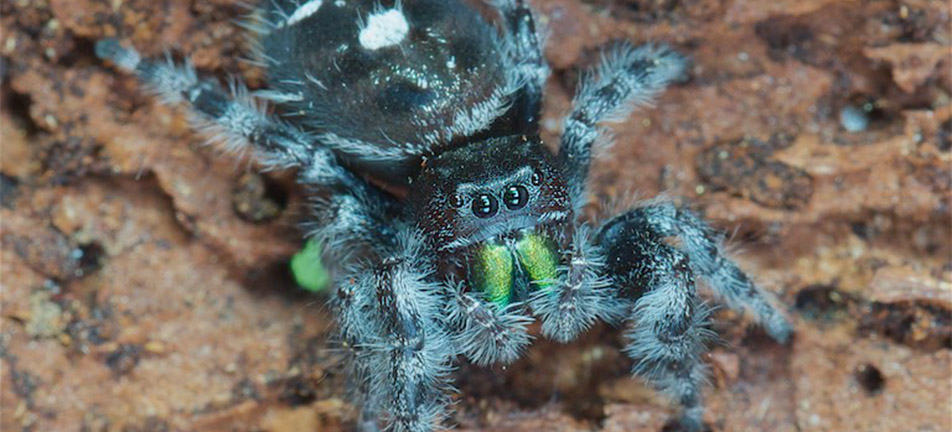
Tan or familiar jumper (Platycryptus undatus)
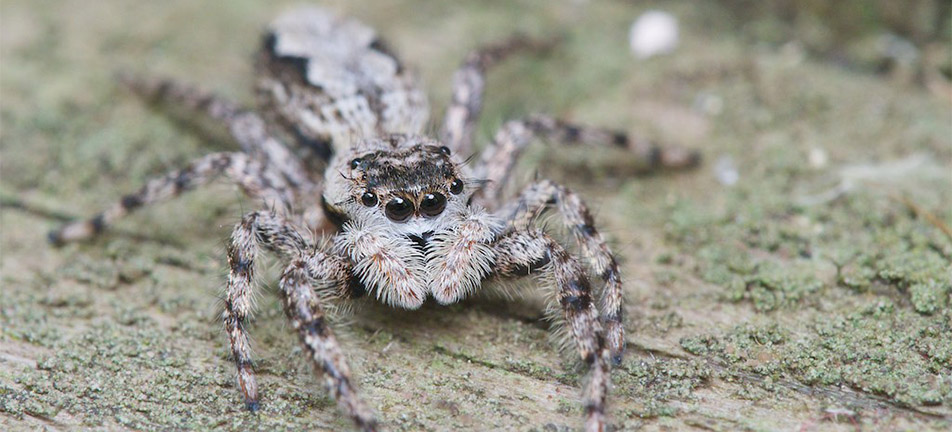
Description: A large jumping spider. Females range from 10.0 – 13.0 millimetres, males from 8.5 – 9.5 millimetres. The body is overall light brown to grey. The abdomen has a lighter middle patch with a dark outline, and chevron markings toward the back. The female has a whitish moustache, while on the male this is reddish.
Habitat: Often found on tree bark, where it is well camouflaged; also walls of buildings and wooden fences
Range: Southeastern Canada and throughout the eastern United States
Seasonality: Spring to fall, often hibernates as an adult under tree bark
Trivia: The markings on this species camouflage it beautifully on lichen that grows on tree bark.
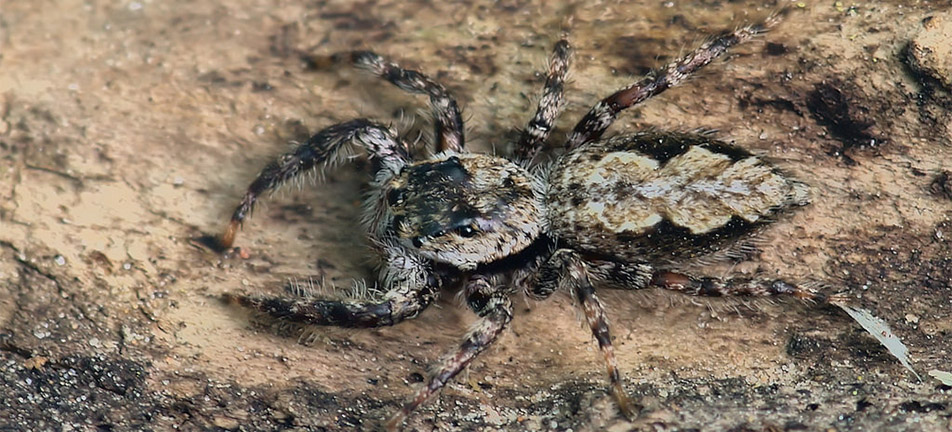
Zebra jumper (Salticus scenicus)
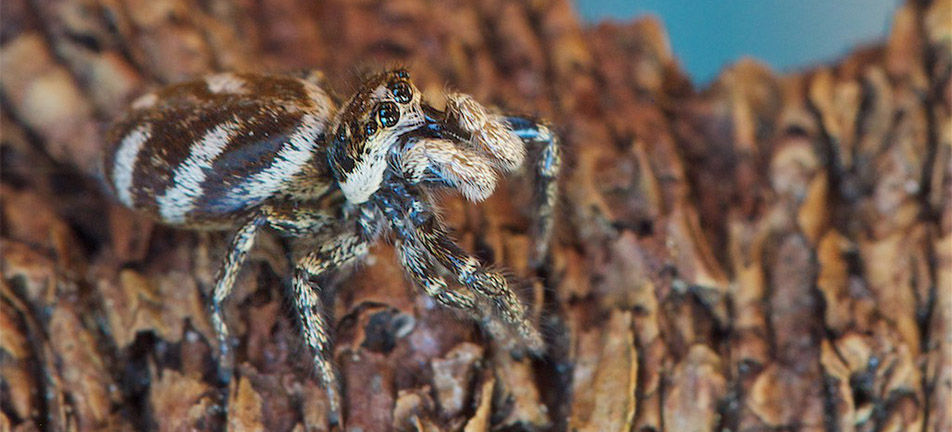
Description: A small jumping spider. Females range from 4 – 6 millimetres, males from 4 – 5. Their body is overall dark brown or black with "zebra-like" white stripes on the abdomen and other white markings on the cephalothorax.
Habitat: Often on or in buildings, which they enter to find food, also on tree trunks, rocks or ground cover
Range: This is a European species that has been introduced around the world, including southern Canada and much of the United States
Seasonality: Males spring and summer; females spring to fall
Trivia: Recent research has shown high intelligence in the jumping spider group, as they can calculate both stalking routes for themselves and likely travel routes for their prey, even when out of sight.
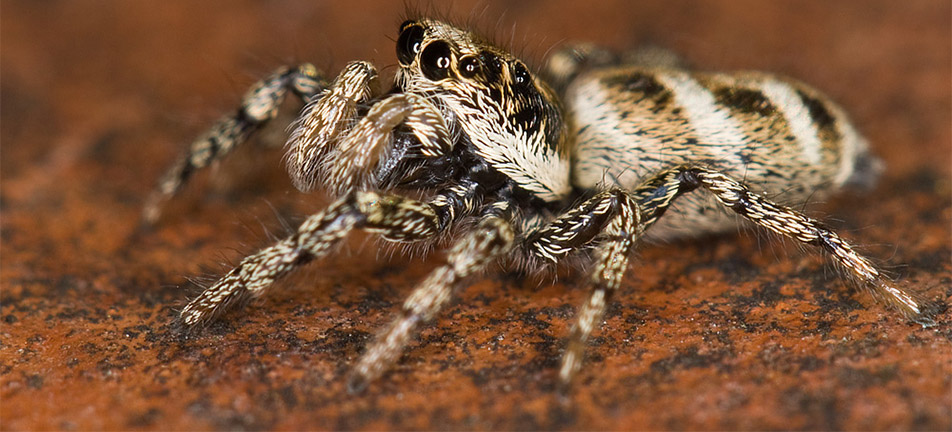
Nursery web weavers
Family Pisauridae
With its long legs and large grey brown body, the nursery web spider somewhat resembles a wolf spider in appearance. The best way to distinguish them is by examining their eye arrangement. Wolf spiders have a very large pair of eyes above a smaller row of four eyes, while nursery web spiders have two slightly curved rows of four eyes that are fairly equal in size. These spiders, which have good vision, will run after their prey over land, skate across water surfaces chasing aquatic insects and some even dive underwater in pursuit of a meal. Females of this family use their fangs and pedipalps to carry their egg sacs.
Brownish-grey fishing spider (Dolomedes tenebrosus)
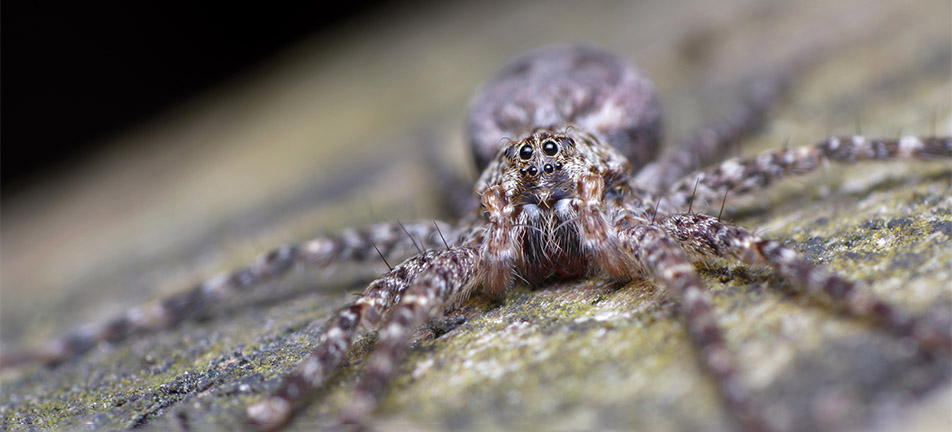
Description: The leg span of this very large spider can exceed 80 millimetres. Female body size ranges from 15 – 26 millimetres, and males from 7 – 13 millimetres. The overall body colour is usually mid-brown or grey. A darker patch on the cephalothorax is outlined by a lighter line along the sides, and the abdomen is variably marked but usually with three "W-shaped" markings near the back. Legs are banded dark and light brown.
Habitat: Forest floor, around buildings, often well away from bodies of water
Range: Nova Scotia to Manitoba, south to southern United States
Seasonality: Males spring, females year-round
Trivia: The leg span of this species is only surpassed in Ontario by the rarely encountered Carolina wolf spider (Hogna carolinensis).
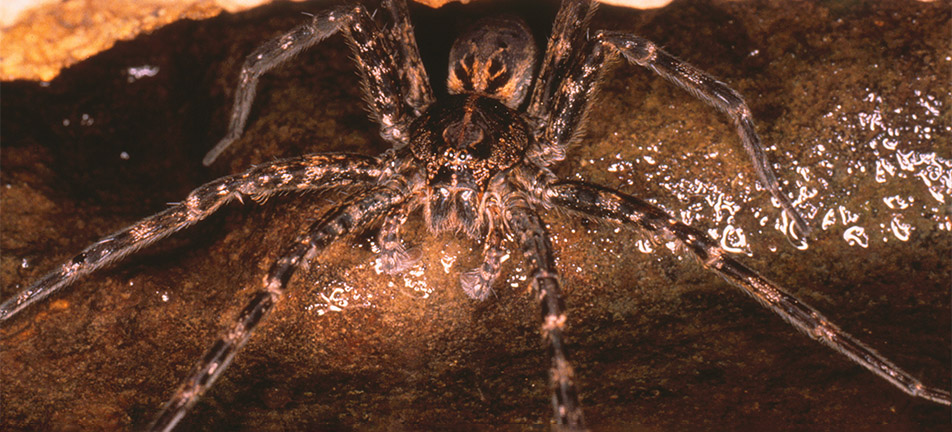
Striped fishing spider (Dolomedes scriptus)
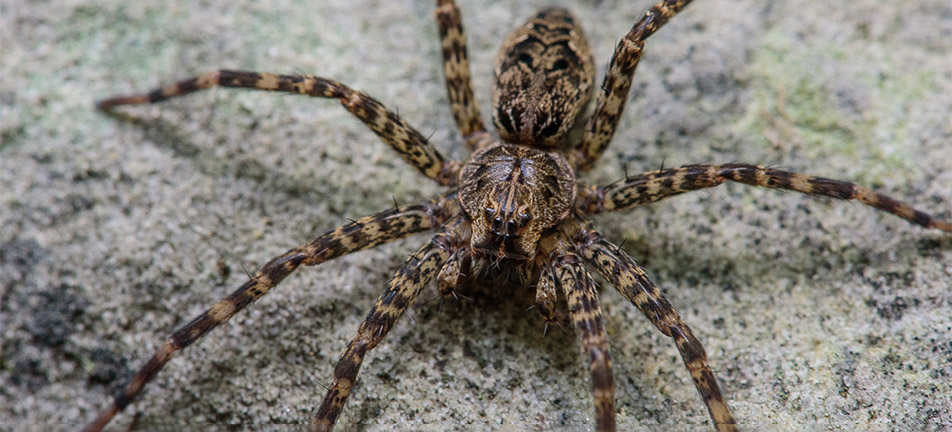
Description: A very large fishing spider, similar toDolomedes tenebrosus. Females range from 17 – 24 millimetres, males from 13 – 16 millimetres. The abdomen usually shows four "W-shaped" marks. Males have a broad whitish band around the entire cephalothorax, and a light band along the sides of the abdomen.
Habitat: Usually found near or on water, often on floating vegetation
Range: Nova Scotia to Manitoba, south to southern United States
Seasonality: Males spring to early summer, females late spring to early fall
Trivia: These formidable hunters can "skate" on the water's surface and eat small tadpoles and fish as well as insects. Because of their habit of climbing onto shoreline structures, they are often called "dock" spiders.
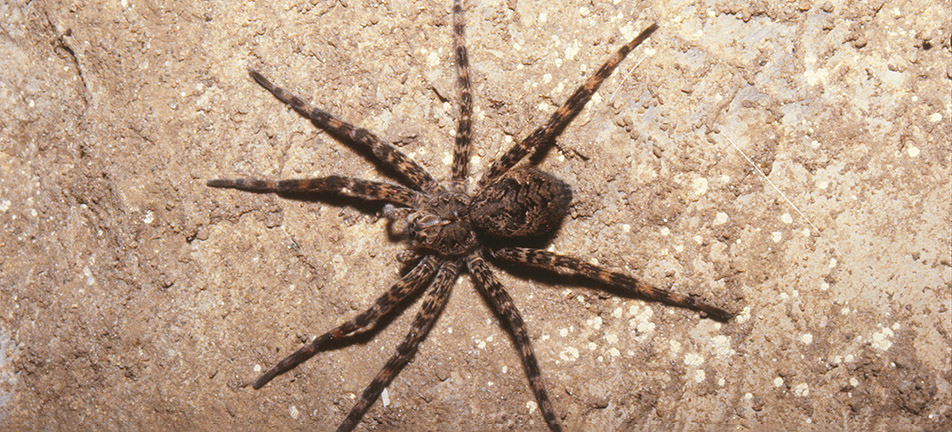
Six-spotted fishing spider (Dolomedes triton)
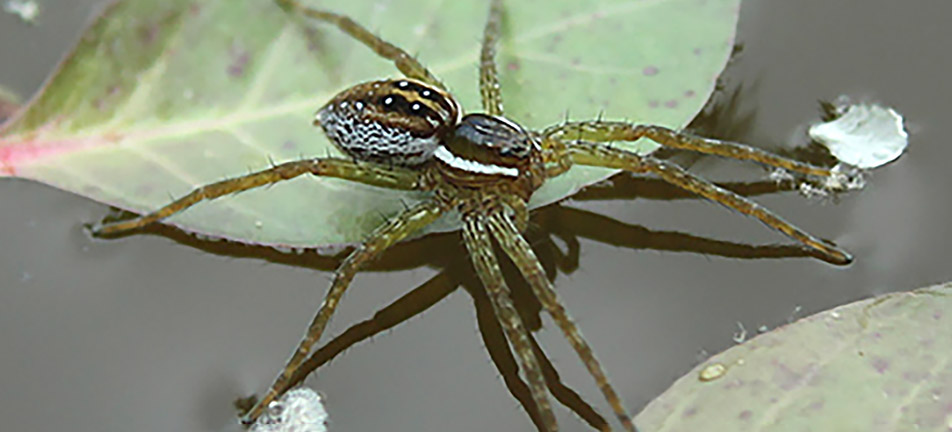
Description: A very large spider. Females from 17 – 20 millimetres, males 9 – 13 millimetres. Females have a brownish cephalothorax. The brown abdomen shows three or four pairs of white spots. There are white bands on the sides of the cephalothorax and abdomen. The male is similar, but with broader white bands on the side.
Habitat: Near or on slow-moving or standing bodies of water, often found nearby on vegetation
Range: Throughout eastern North America, across Canada, north into Nunavut
Seasonality: Year-round
Trivia: This species can dive under water and is frequently found "skating" on the water surface. It is the most aquatic of the fishing spiders in Ontario.
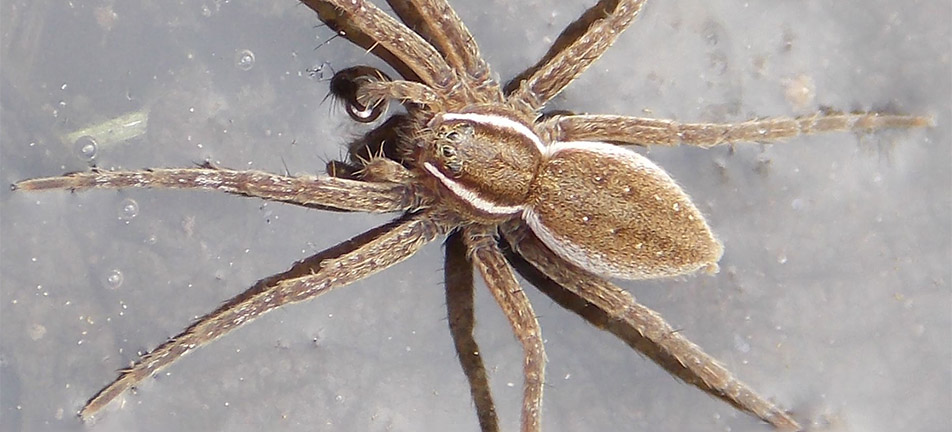
Nursery web spider (Pisaurina mira)

Description: A large nursery web spider. Females range from 12.5 – 16.5 millimetres, males from 10 – 15 millimetres. Overall tan to orangeish colouring. Females have a brown stripe, just wider than their eye span that extends straight back on their cephalothorax and continues, with wavy borders, the length of the abdomen. This stripe may be rather faint on some specimens. Males are overall mid-brown with a small dark cross-like shape on the top of the abdomen. The legs are not banded.
Habitat: Widely found on low vegetation in forests, shrubby areas and fields
Range: Southeastern Canada and eastern United States
Seasonality: Spring to early fall
Trivia: This spider and others in its family are named for their tent-like "nursery webs," designed to protect the young spiderlings when they hatch.
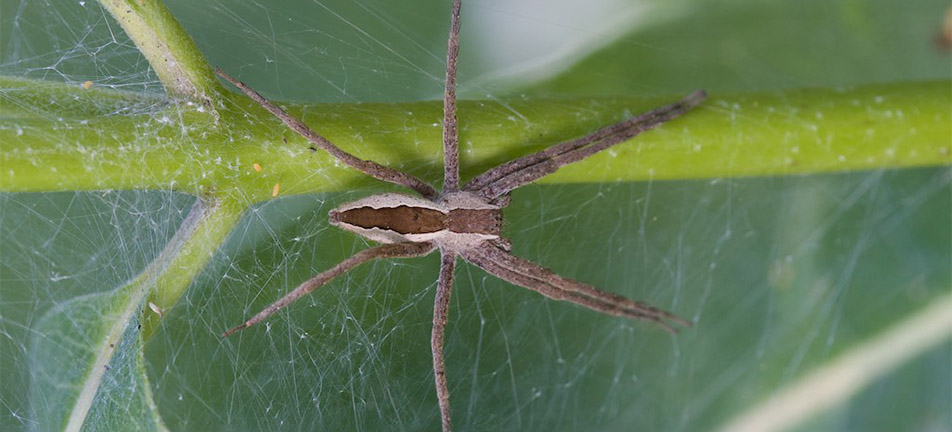
Prowling spiders
Family Eutichuridae
This family is nocturnal, spinning a silken cocoon-like structure to hide during the day and emerging to wander at night, mostly on or near the ground but very often in people's houses. Recently, the subfamily Eutichuridae, formerly included in Miturgidae and which includes the Yellow and Agrarian Sac Spiders below, has been considered a separate family.
Yellow sac spider (Cheiracanthium mildei)
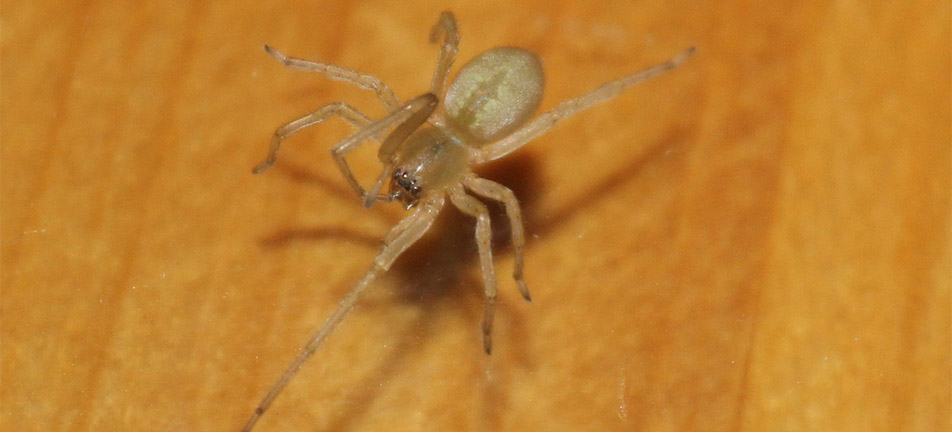
Description: A medium-sized spider. Females range from 5 – 10 millimetres, males from 4 – 8 millimetres. Overall the body is pale yellow and seems somewhat translucent. The chelicerae (below eyes) become black towards the fangs. The legs are black–tipped.
Habitat: Most often encountered indoors, where it wanders walls and ceilings in search of prey; building its silken daytime "sac" or retreats at the intersection of wall and ceiling
Range: Introduced from Eurasia, now widespread in the United States and southern Canada
Seasonality: Year round
Trivia: The native Agrarian Sac Spider (Cheiracanthium inclusum) wanders outside among leaves of trees and shrubs, also in yards and is also often indoors. Both of these species are very similar in appearance.
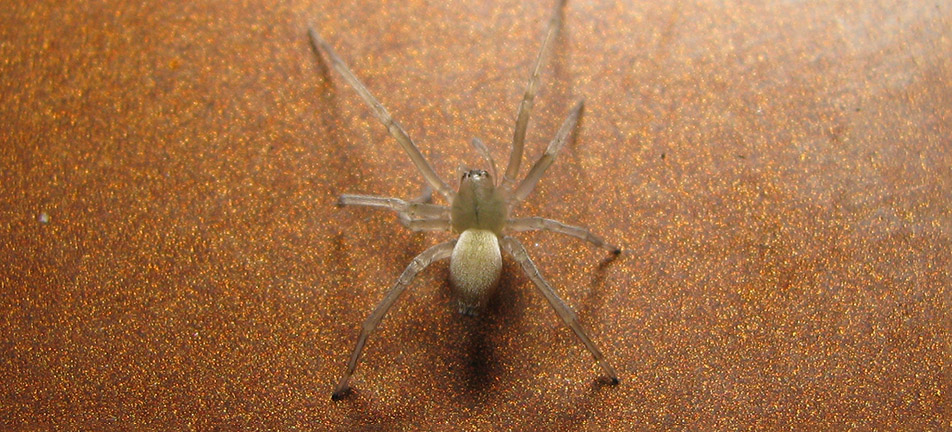
Ground spiders
Family Gnaphosidae
Family Gnaphosidae
Ground spiders never construct a prey-catching web; instead they run down insects on the surface. Mostly nocturnal, they spend the day in a silken retreat. They are often found in leaf litter, or under rocks or logs. Their spinnerets are like tiny cylinders, somewhat widely spaced and often extending beyond the abdomen (visible from above).
Parson spider (Herpyllus ecclesiasticus)
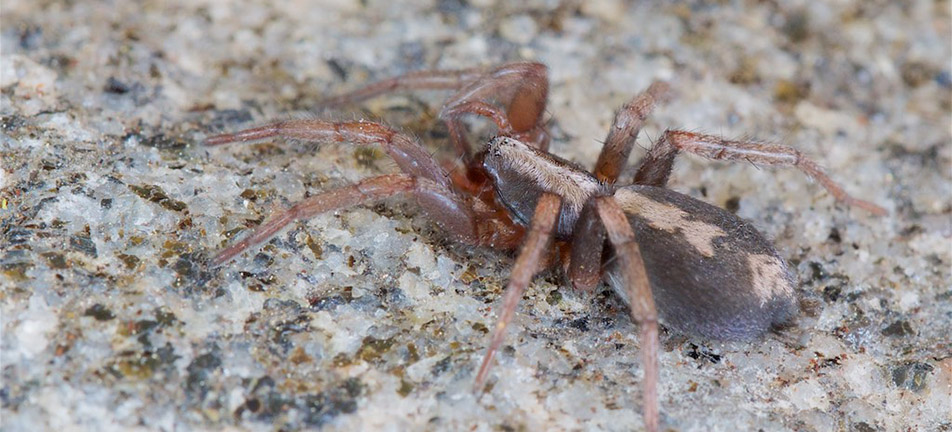
Description: A medium-sized spider. The female is 6 – 9 millimetres, the male 5 – 6 millimetres. The cephalothorax is dark reddish brown, usually with a broad light median stripe. The abdomen is dark grey with a white stripe on the back and an additional white spot at its posterior end.
Habitat: Often in and near houses, under rocks or other groundcover, woodlands and open areas
Range: Southern Canada; eastern and central United States
Seasonality: Year round
Trivia: The abdominal "stripe" on this spider was thought to resemble the cravat worn by preachers, therefore the name "parson" spider.
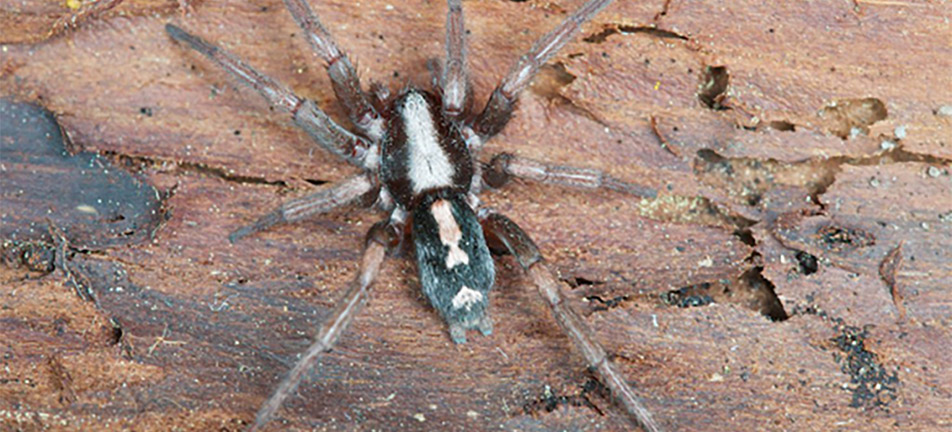
Sac spiders
Family Clubionidae
These spiders are small-to-medium-sized and often light-coloured. This family is named for the silken "sac" that they make each morning in a rolled or folded leaf or under wood (often bark) or stone. Sac spiders hide in their shelter by day, emerging at night to hunt insect prey on the ground or among foliage. They are similar to ground spiders, but their spinnerets are smaller and not as obvious from above.
Leaf curling sac spider (Clubiona riparia)
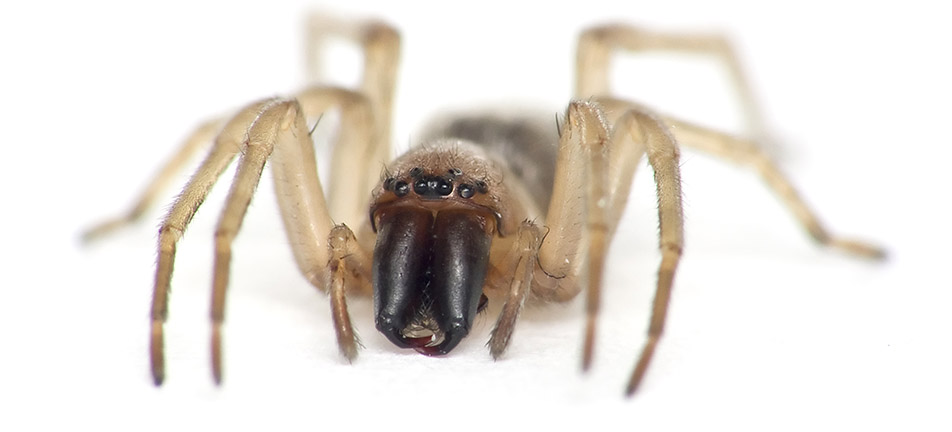
Description: A medium-sized sac spider. Female from 5.5 – 8.7 millimetres, male from 4.4 to 7.4 millimetres. The cephalothorax is mid-brown, darker around the eyes. The chelicerae are very dark. The light brown abdomen has a dark central stripe tapering towards the back.
Habitat: Wet meadows and along streams, especially in long grasses.
Range: Across Canada.
Seasonality: Early spring to early fall
Trivia: The female creates a nesting chamber by twice folding a blade of grass, holding it in place with silk. Within this she spins a silken cocoon for her eggs, and usually stays with them in the chamber until she dies.

Ant-mimic spiders
Family Corinnidae
Many species of this family are convincing ant-mimics in both appearance and behaviour. They presumably gain protection by associating with ants, which are avoided by many predators. This family of spiders catches prey by pursuing it on the ground.
Twobanded antmimic (Castianeira cingulata)

Description: A medium-sized, slender, ant-like spider. Female 6.7 – 8.8 millimetres, male 5.7 – 6.8 millimetres. The body is overall dark brownish red with two white bands on the abdomen's front half. Segments of legs further from body are lighter in colour.
Habitat: Leaf litter and under rocks and wood in forested areas, has also been found in more open areas such as grasslands and sand dunes.
Range: Eastern North America
Seasonality: Females year-round, males in summer
Trivia: Often observed with ants, day or night. This species increases its similarity to ants by waving their front legs in the air when pausing (to resemble antennae).
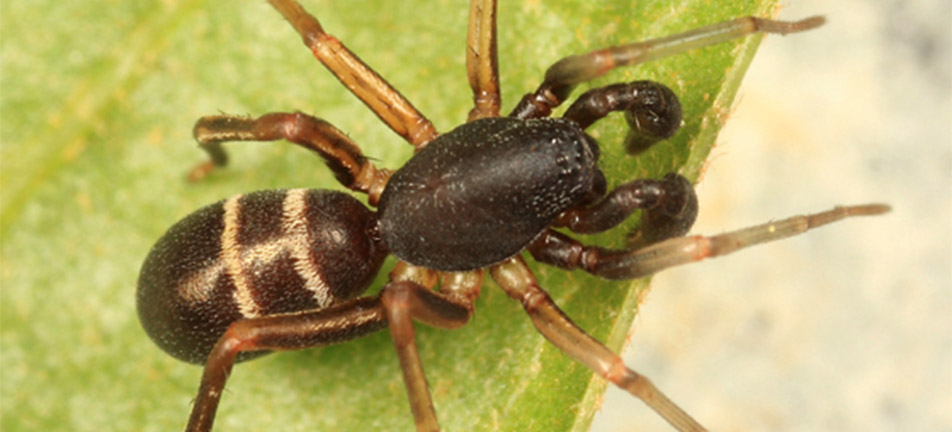
Running crab spiders
Family Philodromidae
Running crab spiders
Originally grouped with crab spiders, this is now considered a separate family. They tend to be medium-sized and light-coloured (light brown or grey). Many of these species hold their legs crab-like (out to the side) when at rest. They are active hunters.
Slender crab spider (Tibellus oblongus)

Description: A medium-sized spider. Female from 6 – 10 millimetres; male from 5 – 7 millimetres. Its body is overall light brown. As its name suggest, the abdomen is very slender (about three times as long as wide ). A dark middle stripe extends from its eye region to the tip of its abdomen where there are two small dark spots, one on either side of the stripe. There are also thin lighter stripes that camouflage the legs and body.
Habitat: Open grassy areas
Range: Across southern Canada and throughout the United States
Seasonality: Late spring to early fall
Trivia: This spider often rests with four legs straight forward and four back, aligning perfectly with thin, grass leaves on which it hides.

Running crab spider (Philodromus rufus)
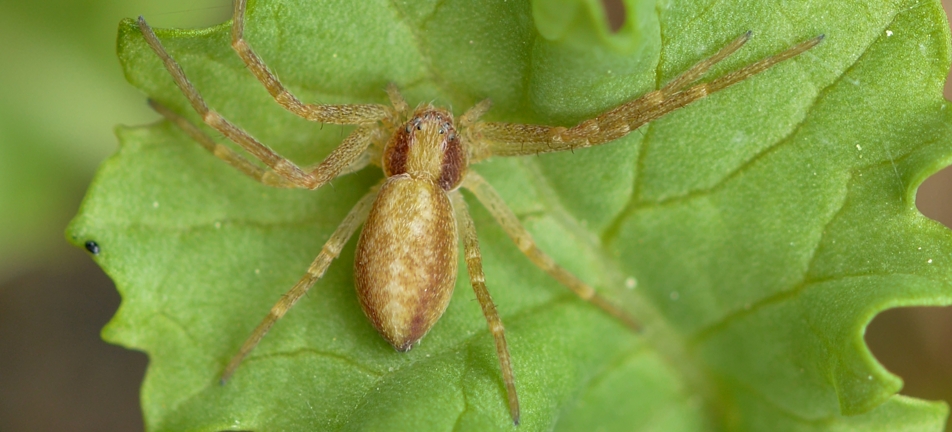
Description: Although other species of Philodromus may be larger, this species is a fairly small spider. Females are 2.7 to 4.5 millimetres long, males range from 2.5 to 3.5 millimetres. The cephalothorax and abdomen are light-coloured in the middle, and both are darker (light reddish) along the edges. The abdomen has a reddish stripe down the middle of its lighter central patch. Like many other true and running crab spiders, legs are held in a laterigrade position when at rest.
Habitat: Found in a variety of habitats, including forests and grasslands, on tree foliage, grasses and other herbaceous vegetation.
Range: Throughout North America (except south-eastern U.S.)
Seasonality: Adults can be found May to August
Trivia: These spiders are well camouflaged, but when they move, as their name suggests, they can move quickly. This helps them in their role of active hunters.
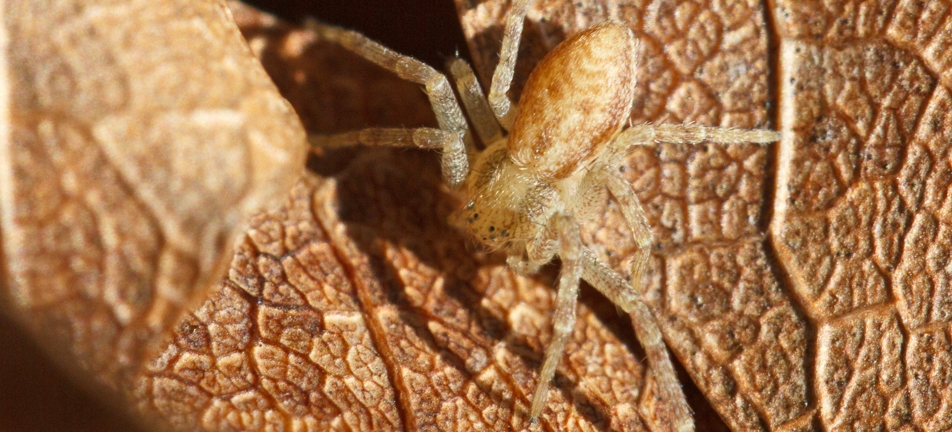
Ambush hunters
Crab spiders
Family Thomisidae
Like their namesake, crab spiders extend their legs to the sides. The first pair of legs often has sharp spines to capture and hold prey, while the second pair of legs is longer than the other pairs. Crab spiders may climb in and around plants or on the ground in search of prey, or wait patiently on flowers, using camouflage to ambush unsuspecting insects.
Goldenrod crab spider (Misumena vatia)
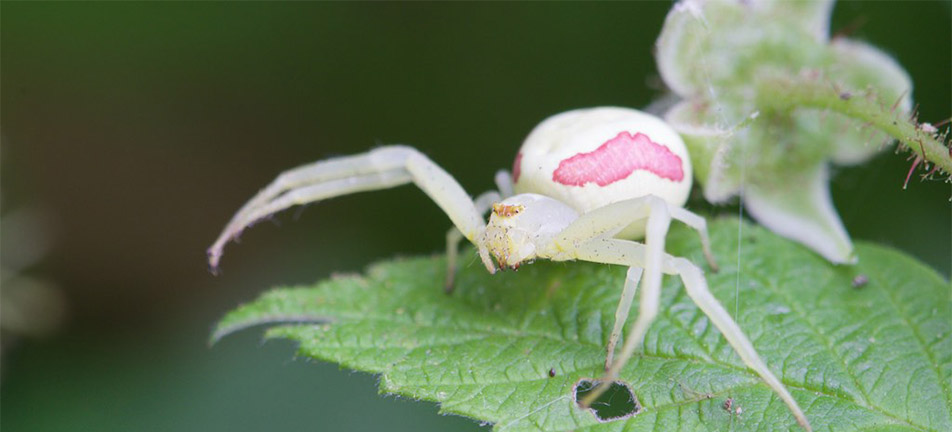
Description: A fairly large crab spider. Females measure 5 – 10 millimetres, and males are smaller, at 3 – 4 millimetres. Although colour in this species varies, it is typically yellow or white with red streaks on each side of the abdomen, and with a reddish or orange patch around the eyes. This species closely resembles the whitebanded crab spider (Misumenoides formosipes), which has a white or pale ridge below its eyes to distinguish it from the goldenrod crab spider.
Habitat: Meadows, where the spider often waits for prey on yellow or white flowers
Range: Throughout southern Canada and the United States
Seasonality: Summer to early fall
Trivia: To camouflage on white or yellow flowers, this spider is capable of changing colour over a period of days, from white to yellow or yellow to white.
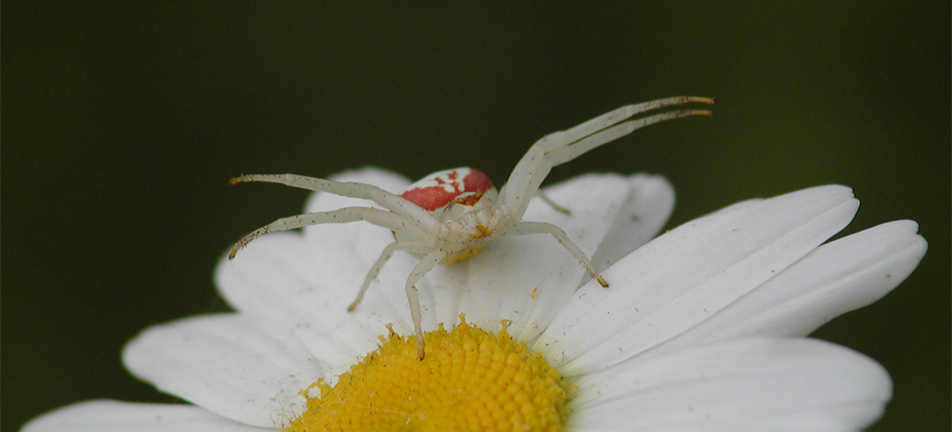
Ground crab spider (Xysticus species)
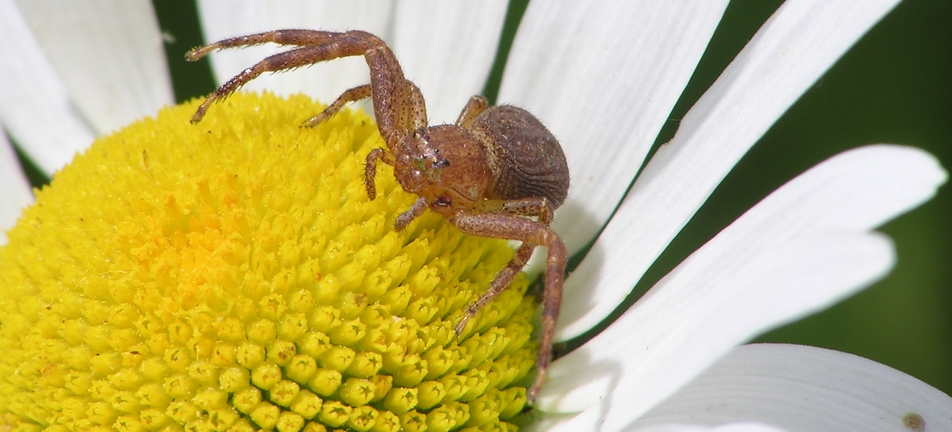
Description: These are small to medium crab spiders. Female 4 to 9 millimetres, male 3 to 7 millimetres. This group of crab spiders ranges from grey to brown in colour, and includes several species in our area.
Habitat: May be on the ground or up in plants, waiting patiently to ambush prey, but is less often on blossoms than the goldenrod or white-banded crab spider.
Range: Some species range across southern Canada
Seasonality: Mid-spring to mid-fall
Trivia: The ambush technique and potent venom of crab spiders allow them to attack and subdue insects much larger than themselves, including wasps and bees.

How to help spiders

- Protect natural habitat, and create some of your own. A profusion of flowers in a small meadow or a small section of garden or lawn will attract many spiders.
- Provide a variety of natural habitats including shrubs, meadow, forest and ponds.
- If you find a spider inside your home, putting it outside in cold weather will probably kill it. It's better to put it in an attic or basement, or even to let it wander where it likes.
- Avoid using pesticides.
Resources
- Common Spiders of North America, by Richard A. Bradley
- Spiders and Their Kin (A Golden Guide) by Herbert and Lorna Levi
- Spiders of the North Woods by Larry Weber
- www.spiders.us
- www.bugguide.net
- Biodiversity sheets: uoguelph.ca/arboretum/educationandevents/arboretumbooks
Acknowledgements
- Design: Noah Cole
- Editing and proofreading: Jaklynn Nimec, Ron Corkum
- Photography: John Reaume, Camille Tremblay Beaulieu, David Coulson, Eric Eaton, Brett Forsyth, Noah Cole
- Expertise: Tom Mason, Gergin Blagoev
Written by Dan Schneider
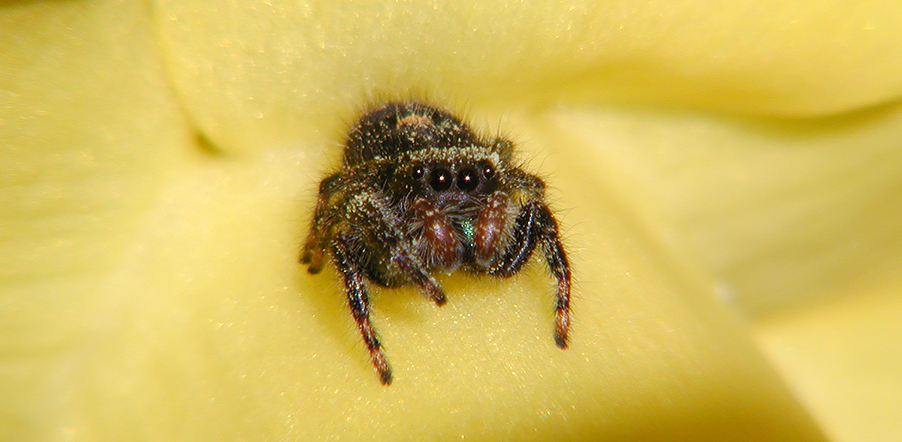
Small Brown Spider With Yellow and Black on Back
Source: https://onnaturemagazine.com/spiderguide.html
0 Response to "Small Brown Spider With Yellow and Black on Back"
Post a Comment